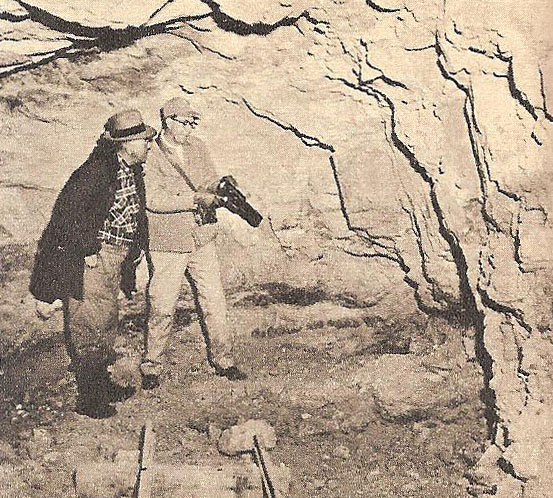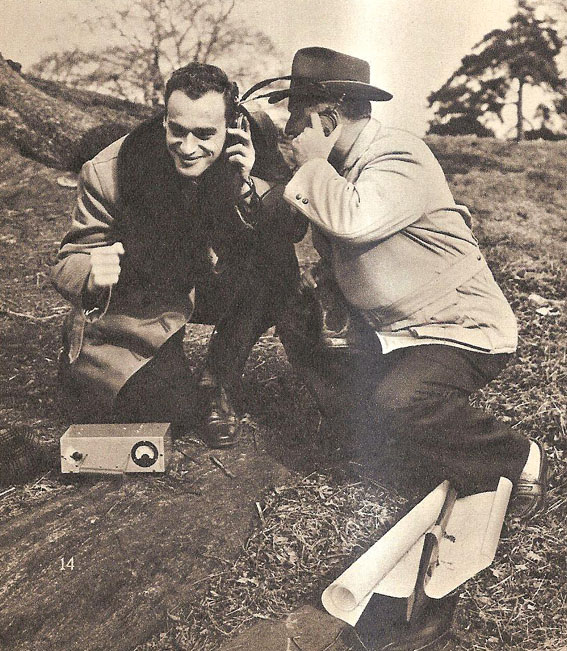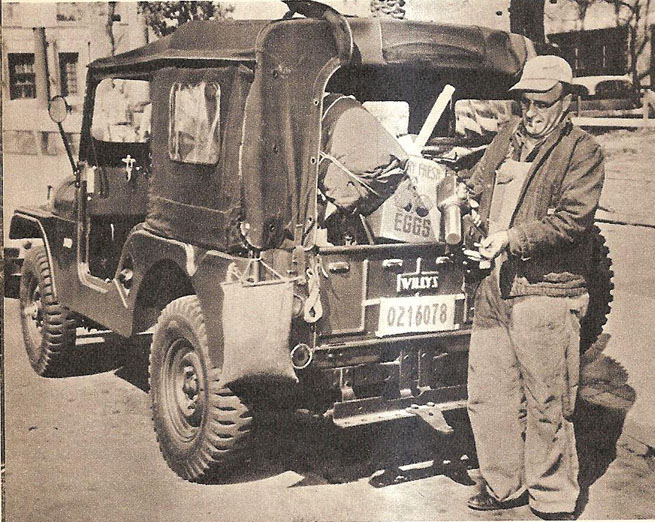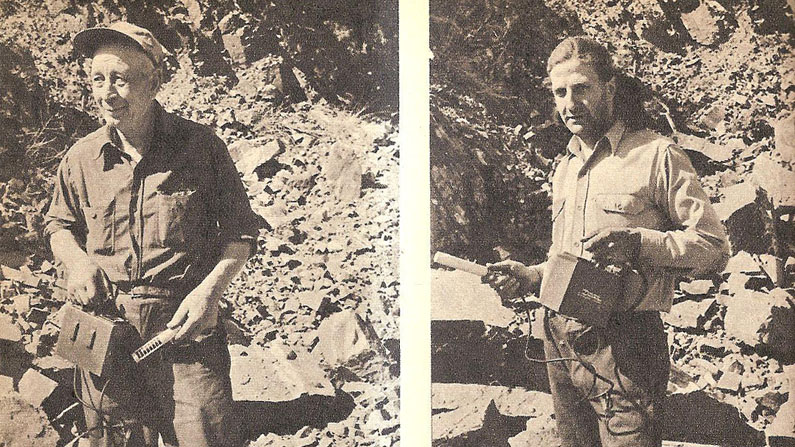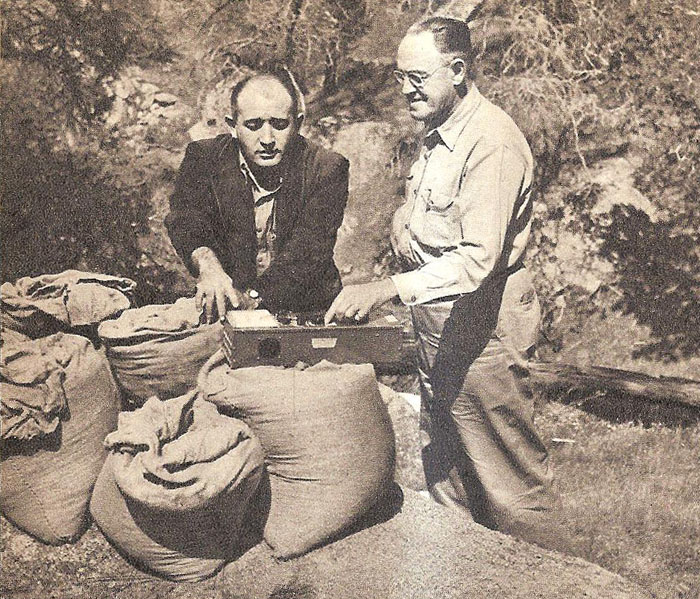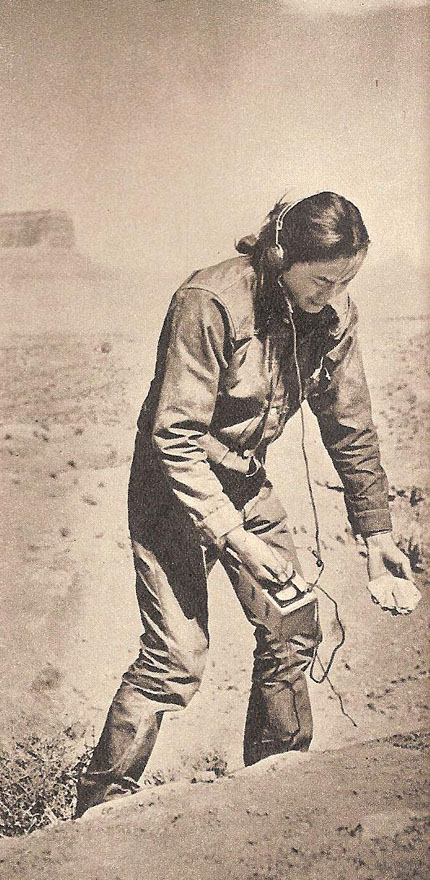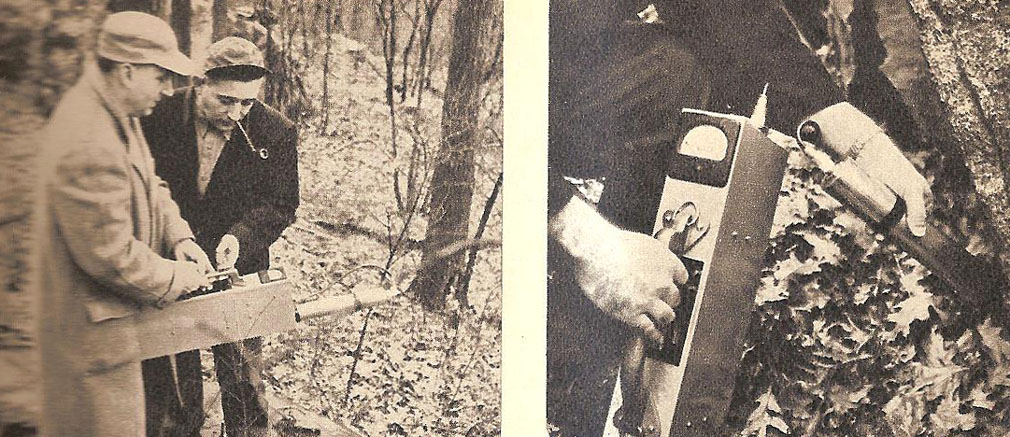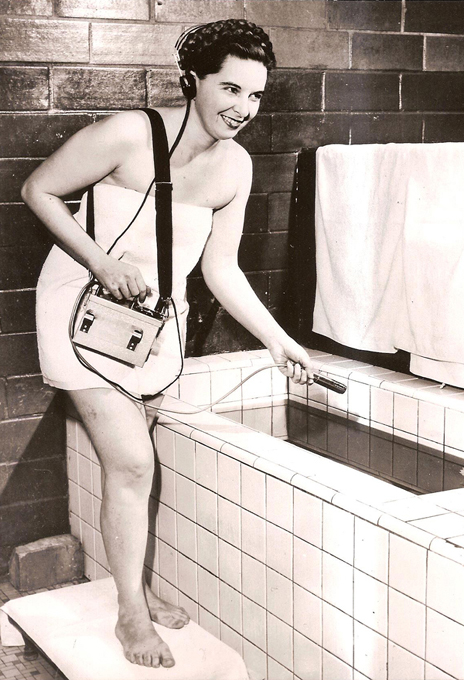
Press Photographs
Press photos with radiation detection instruments were very popular in the 1950's. This section contains a series of press photos showing individuals using radiation detection instruments for prospecting, advertisements, television shows, etc. The description that was provided with each photograph is included along with the origin and date if included.

Atomic Bath - Preparing to take a bath, Blossom Barton of Claremore tests the water with Geiger counter. The water around Claremore has such a concentration of radium that it sets the counter to ticking like an atomic pile. In this age of atomic activity, prospecting for nuclear materials in the bathtub may become a good, clean sport, United Press Photo, Jan 1955.
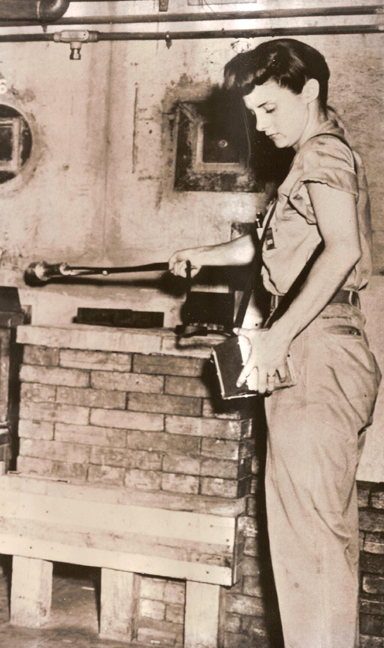
Geiger Counter, held by girl, as precaution against deadly atomic rays, is finding peacetime use in atom-soil experiments, tracing isotopes in plant growths, Atomic Energy Research, Dec 1947.
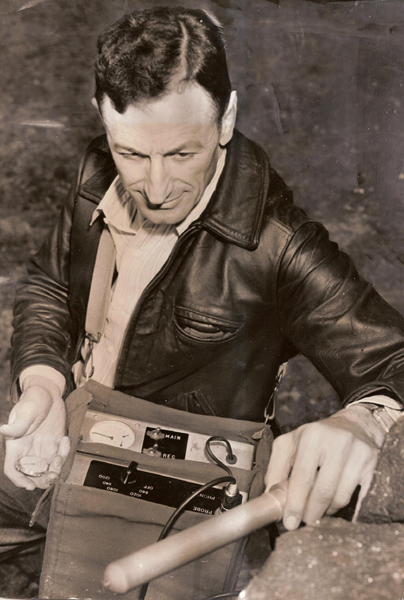
Atomic Era - prospecting technique is demonstrated by Dr. George Selfridge, mineralogist for Atomic Energy Commission. He carries Geiger counter which registers on dial if uranium is near. AEC bonus has spurred hunt for mineral, Hearst Predate Services, May 1948.
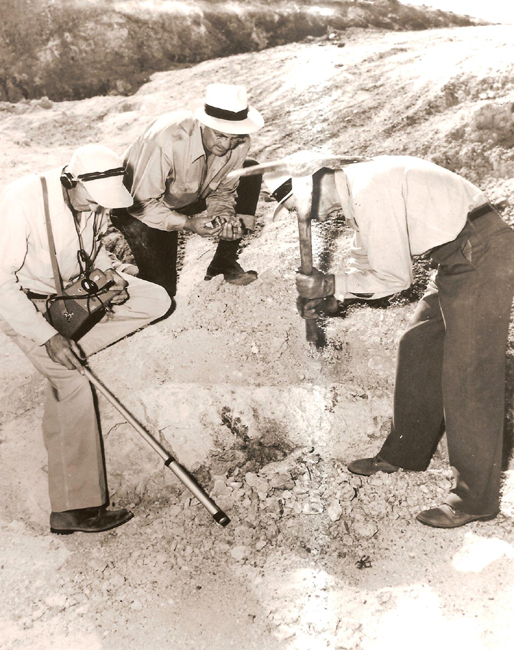
The Atomic Stampede - prospecting for uranium became a passionate pastime for many westerners during the 1950's, Utah Historical Society, PBS TV Special from Aug 1994, 1950s.
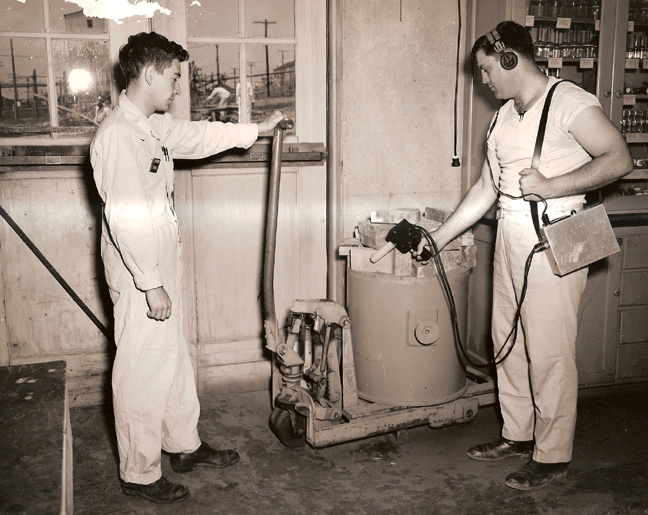
Dangerously radioactive materials are transported fro the pile to the "hot" laboratories, or from laboratory to laboratory, in special lead containers such as the one shown here. The one is almost solid lead and is for extremely active samples. It is handled by special trucks and cranes. David Warden is using a probe counter to examine the container for radiation leakage before Mr. Vanneman proceeds. Note washable uniforms and radiation measuring file badges and pocket pencil size radiation meters. Clinton Laboratories, Oak Ridge, Tenn. Jun 1946.
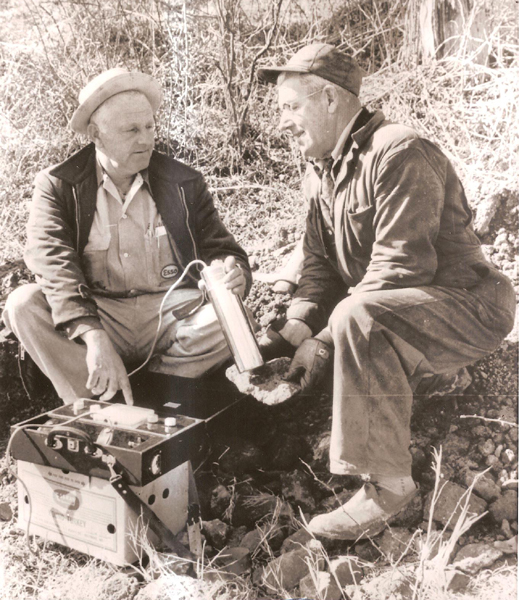
Discovering Uranium - prospector Edward (Zeke) Roberts uses a Geiger counter to check the radioactivity of a rock held by Clarence L. Kemper, the Linthicum, Maryland, contactor who unearthed uranium on the farm of Frank Giampaoli near here. They detected about 15 radioactive acres on the farm. Geologists at the Bureau of Mines at College Park said the samples from the farm were very good, Elkridge, Maryland, Feb 1959.
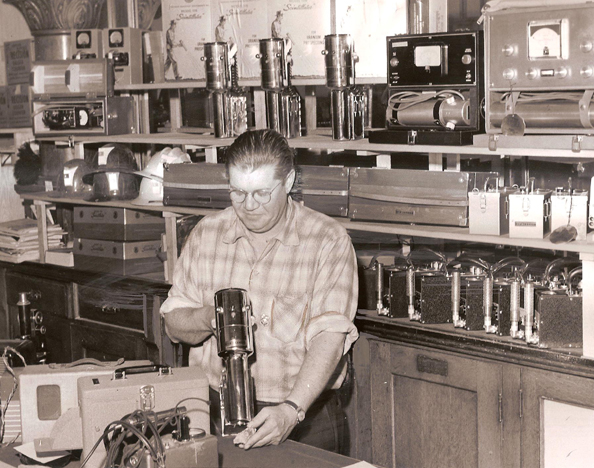
Uranium has brought new-found riches to Durango and the San Juan Basin. Here Earl Heatwole, partner of the G&H Uranium store, tests a sample of ore with a scintillator. Experts say the G&H store is the center of much of the region's uranium activity, Mar 1955.
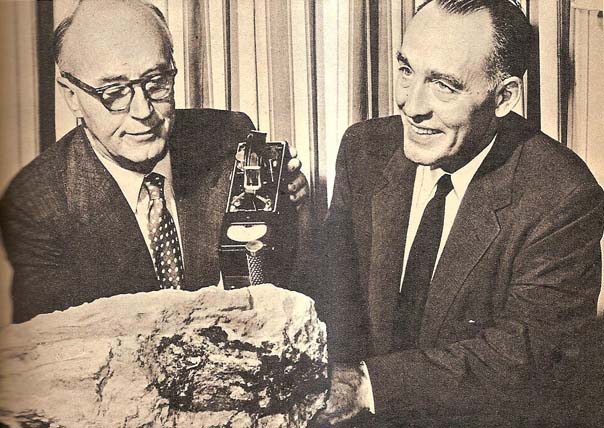
Vernon Pick, right, got $9,000,000 for his uranium find from Atlas Corp. Prexy Odlum, left, from Go Dig Yourself a Fortune by H. Kursh in Mechanix Illustrated May 1955
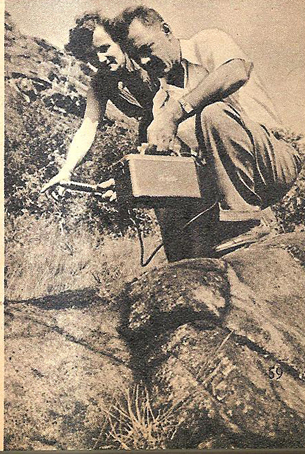
Ed Chalmers, a spare-timer who found uranium 50 miles from New York, continues his Hudson Valley hunt with Mrs. C, from Go Dig Yourself a Fortune by Harry Kursh in Mechanix Illustrated May 1955
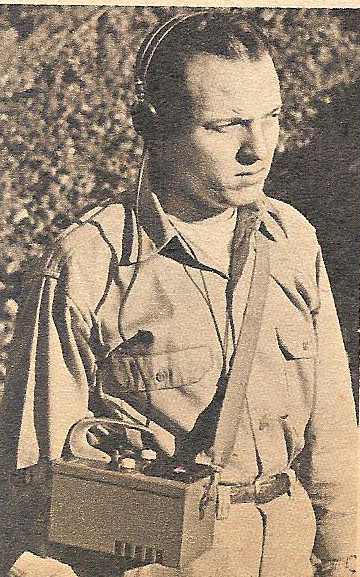
Self-contained Uranium Scout has its tube mounted entirely within the sturdy instrument case. Available at Fisher Research Labs., Inc., Palo Alto, Calif., from Go Dig Yourself a Fortune by Harry Kursh in Mechanix Illustrated May 1955
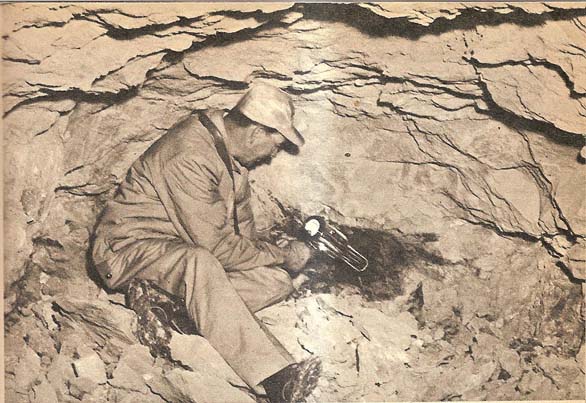
B.W. Burford checks his Luckytex uranium mine with a Precision Radiation scintillator, from Go Dig Yourself a Fortune by Harry Kursh in Mechanix Illustrated June 1955
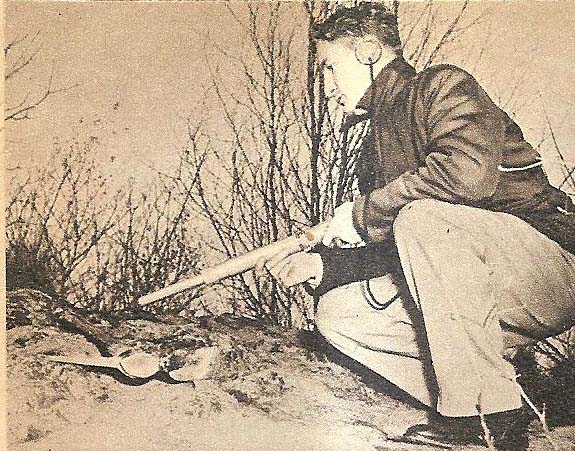
Radiatector reveals any radioactive substances in ore. Unit weighs less than 2 pounds and is waterproof, from Curtiss-Wright Corp, from Go Dig Yourself a Fortune by Harry Kursh in Mechanix Illustrated June 1955
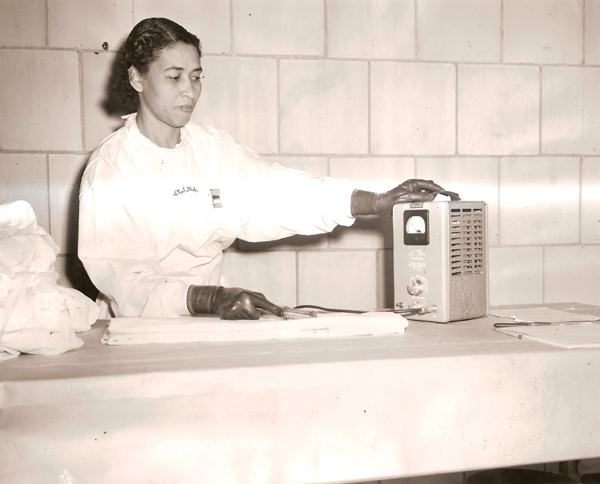
Photo from 1953 featuring Atomic Age Hospital Miss Elberta Lewis giving linens of the Argonne Cancer Research Hospital at the University of Chicago a radioactive check with a Geiger counter. If the garments and bed clothes of patients receiving isotopes for treatment are contaminated, they are given special washings before they are placed in the regular hospital laundry, Mar 1953.
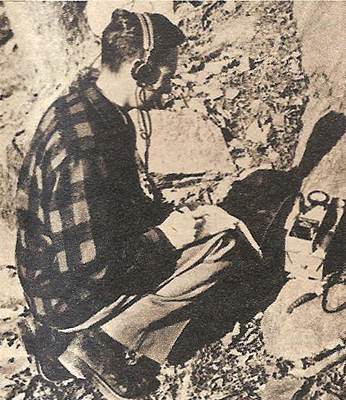
Prospecting with Geiger Counter from Prospecting for Uranium article Atomic Energy Commission, Grieger's Encyclopedia 1950
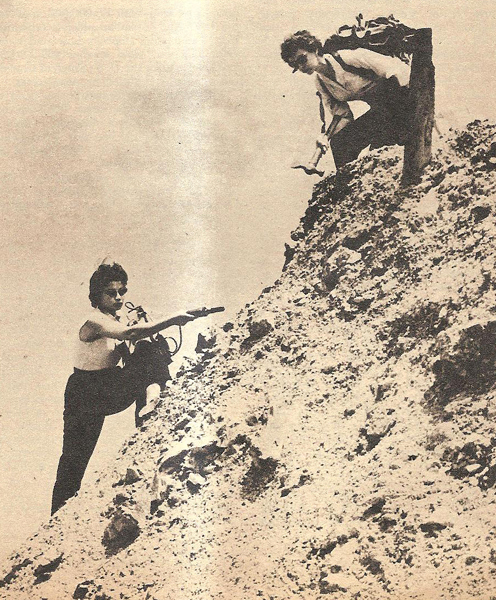
No gold diggers, these girls are after the most valuable mineral of all - uranium, from How to Take a Uranium Vacation by H. Kursh in Man's Magazine Jun 1957.
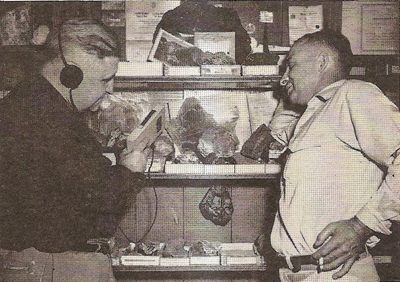
Joubin Article in Life Magazine 1955
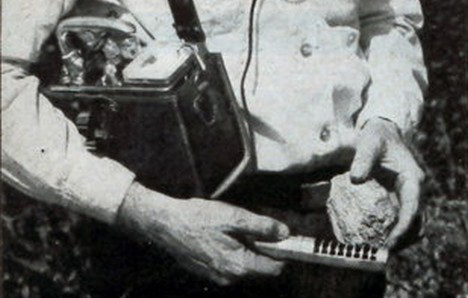
Detector measurement of ore sample
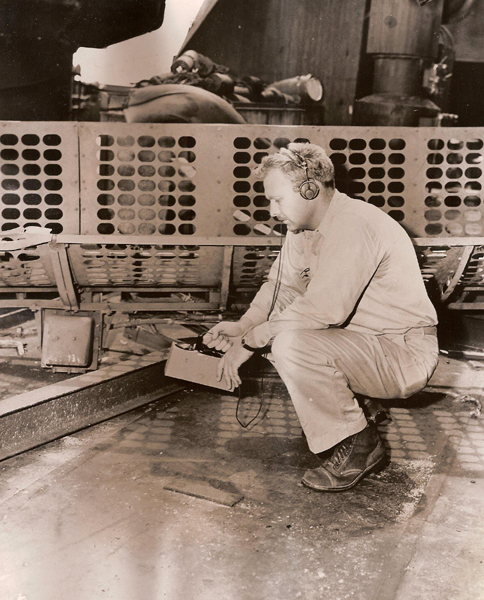
Medical Geiger counter - Atom bombed at Bikini, the U.S.S. New York is tested for radioactivity by Dr. James T. Nolan, radiologist, who uses special type of Geiger counter that registers atomic particles by clicking sound in earphones, International News Photo, Sep 1946.
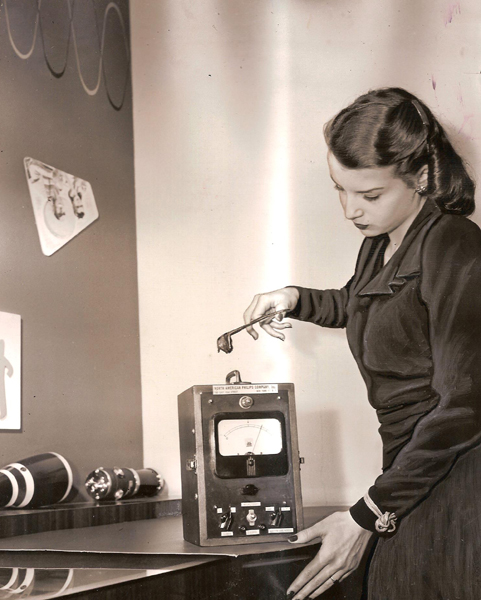
Medical Geiger counter - Radioactive uranite, substance from which radium and uranium are made, is tested by Barbara West. Portable radiation meter's dial registers radioactivity, Sep 1946.
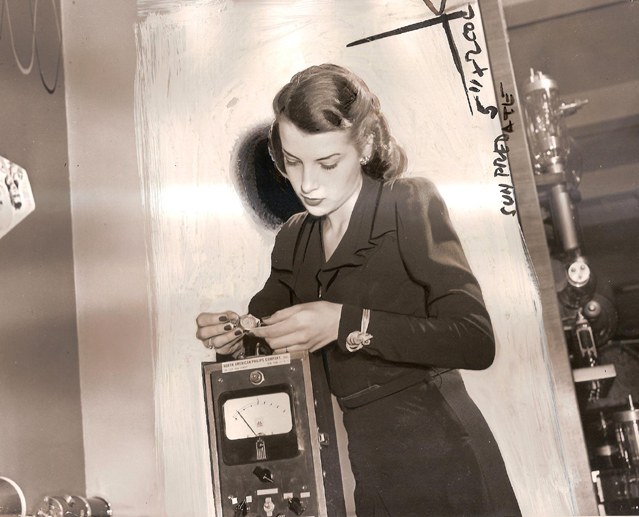
Medical Geiger counter - Radium content of luminous watch dials is enough to move the needle of sensitive Geiger counter. Such machines will guard against lethal atomic rays of tomorrow, International News Photo, Sep 1946.
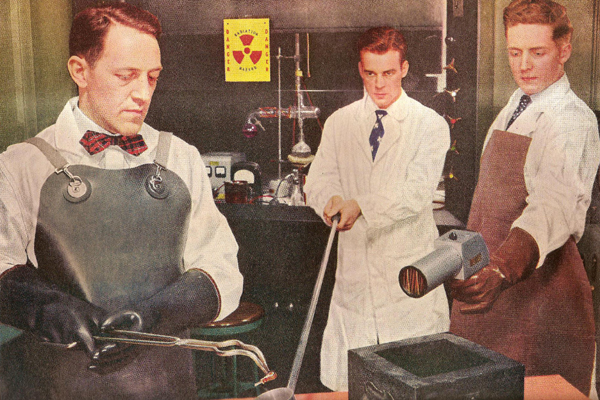
Atoms from Oak Ridge Come to Detroit - Chrysler Laboratories Radioactive Materials Room, 1950s.Dangerously radioactive materials are transported from the pile to the hot laboratories, or from laboratory to laboratory, in special lead containers such as the one shown here. This one is almost solid lead and is for extremely active samples. It is handled by special trucks and cranes. David Warden is using a probe counter to examine the container for radiation leakage before Mr. Vanneman proceeds. Note washable uniforms and radiation measuring film badges and pock pencil size radiation monitors, Clinton Laboratories, Oak Ridge, TN, Jun 1946.
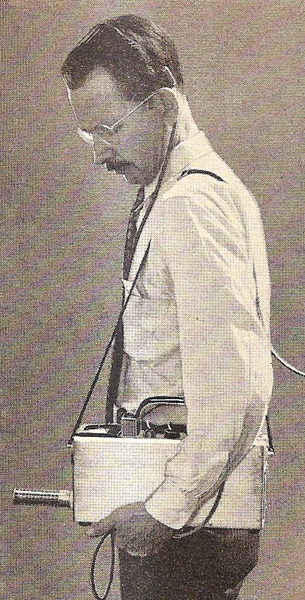
Portable Geiger counter in use from R. Ives in Radio and TV Magazine 1956
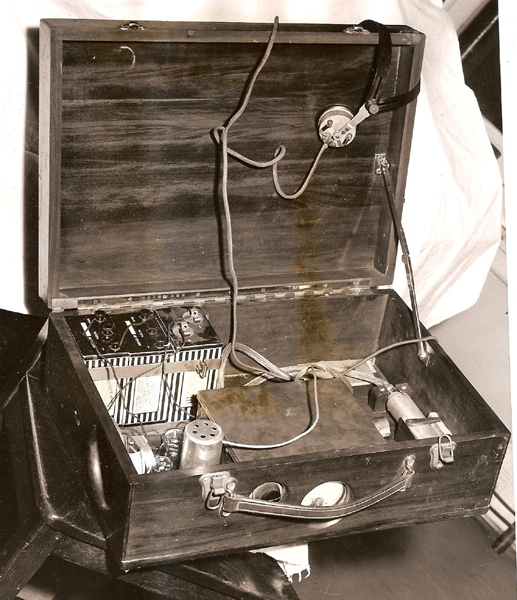
Geiger counter used by Dr. Kenneth Corrigan to located $7,000 worth of lost radium at Harper Hospital in Detroit, Michigan August 19, 1942
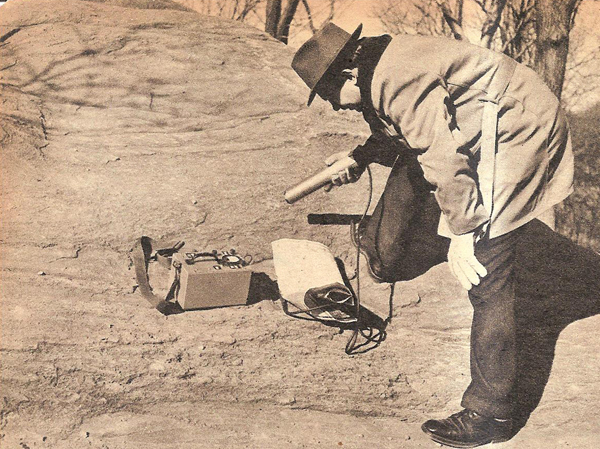
Strike It Rich with a Scintillation Counter by Jim Cavaseno in Mechanix Illustrated June 1956
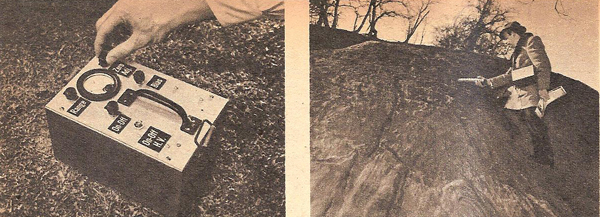
Last step in readying the counter is the adjusting of the zero control on the meter (left) and The detector is built into a probe unit for greater mobility and ease of handling from Jim Cavaseno in Mechanix Illustrated June 1956
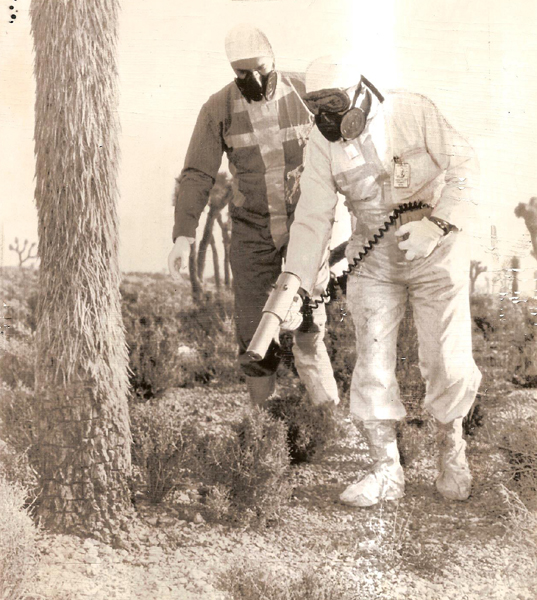
Survival City - they'll check effects of blast, Paul Brandt of Louisville, Ky, and Walter D. Behlen of Columbus, Oh, test their scintillator today before proceeding to this cluster of buildings and installations to check effects of today's atomic explosion. They are industry participants in the program sponsored by the Federal Civil Defense Administration to determine survival chances in a atomic attack, Aug 1955.
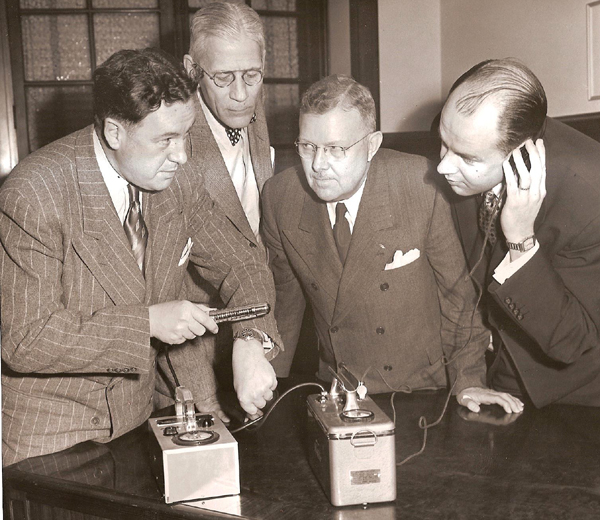
The Radiation Detector Gun, a device that looks like the business end of a futuristic ray gun got a close scrutiny as it was unveiled here today. It's a new radiation detector "gun" that can be used by civilian defense forces in the event of an atomic explosion. The gun will be shown at the Westinghouse exhibit on atomic energy at the 1950 Chicago Fair, Apr 1950. (L-R: Howard C. Baldwin of the AEC, Fair Pres. Kent Chandler, Westinghouse VP Fred Whiting and Crosby Kelly, executive manager of the Fair.
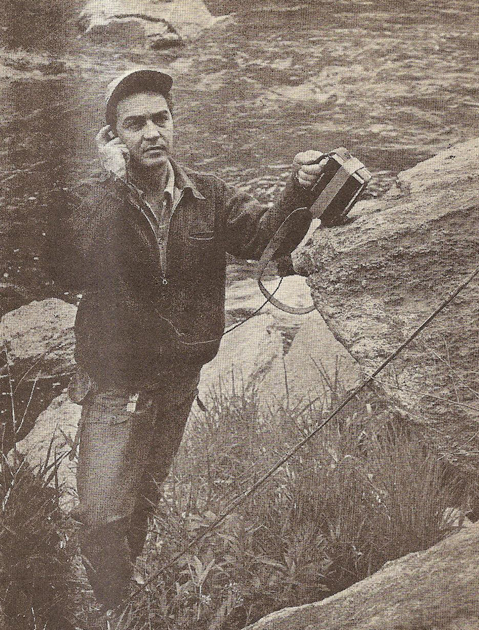
William Bradbury of Marbledale, Conn., tests rock on bank of Shepaug River for radioactive mineral, gets slight reaction, but not enough to take a sample. From The Third Fever by Woodrow Jarvis, Field and Stream, June 1953.
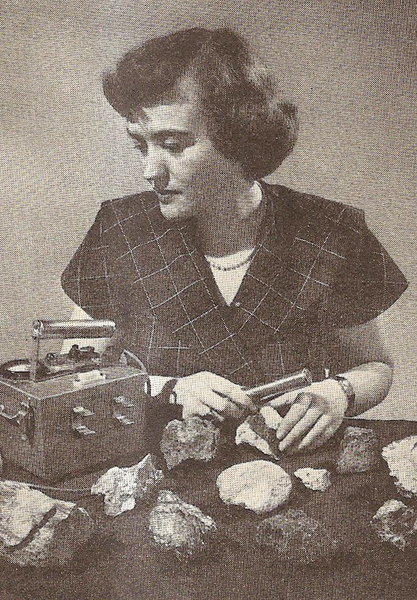
There are samples of uranium ore displayed by Joan Brown, mineralogist in the Atomic Energy Commission's laboratory. From The Third Fever by Woodrow Jarvis, Field and Stream, June 1953.
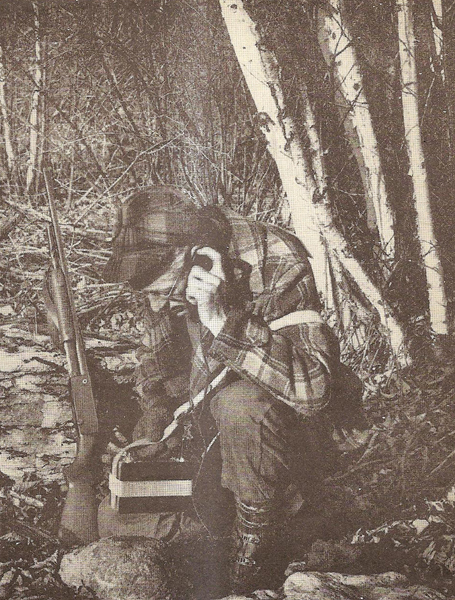
Deer hunter John D. Steel examines a rock formation at Spring Bay on the St. Mary's River about 40 miles southeast of Sault Ste. Marie, Michigan. From The Third Fever by Woodrow Jarvis, Field and Stream, June 1953.
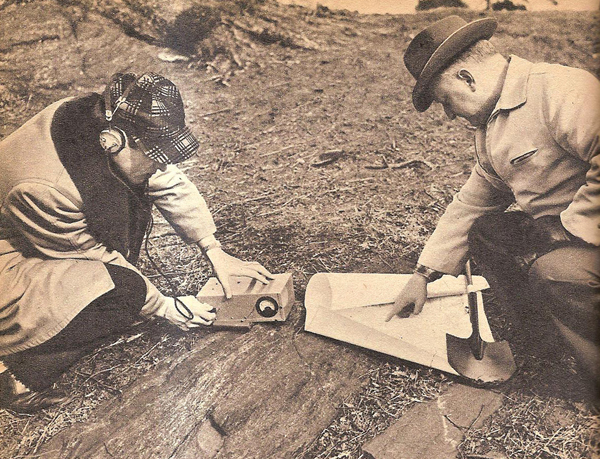
This pair of hopeful prospectors will soon know whether they struck it rich, from Three-Way Geiger Counter in Mechanix Illustrated May 1955
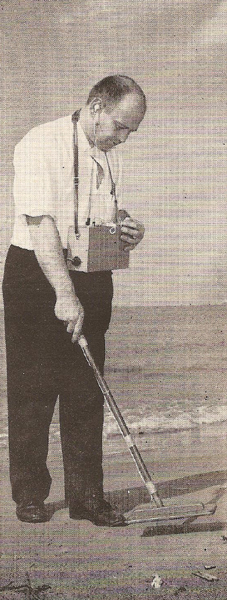
If hidden treasure is not the reward you seek, a buried metal pipe can be located in short order, unit combines a Metal Locator, a Geiger Counter and a Radio from Treasure Finder's Pal by Gus Wesenfeld in Popular Mechanics Aug 1961
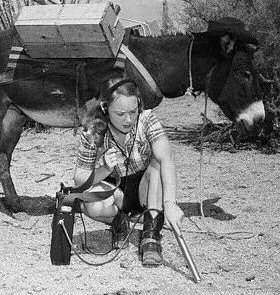
Prospecting with a Geiger Counter 1950's
(Image was recently shown on the American Restoration TV Show titled "Atomic Restoration" (Volume 4, Ep. 9, 4/23/13) on History Channel when Rick restored an atomic age Uranium Detector)
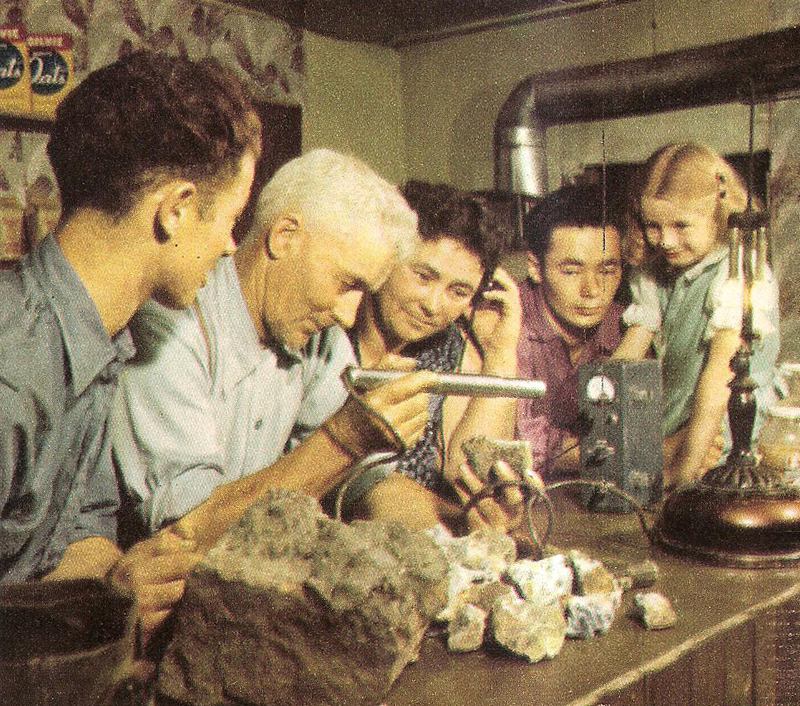
Collier's Magazine
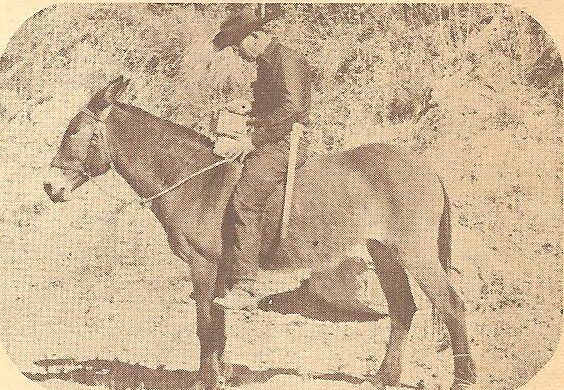
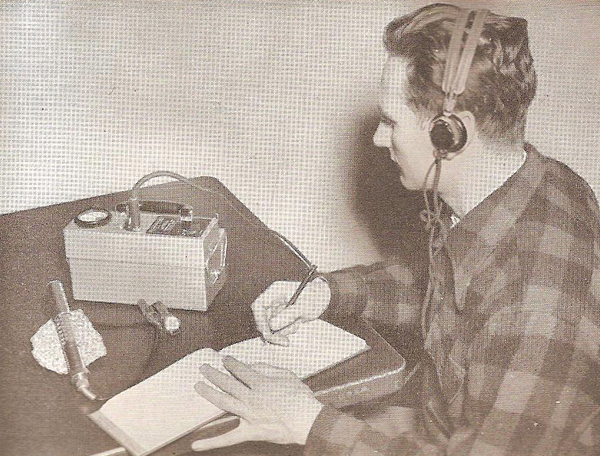
A prospector make a Geiger counter test to obtain a rough assay of the radioactivity of a rock sample. Note equipment used in making the test, from Prospecting for Uranium by AEC and USGS 1951.
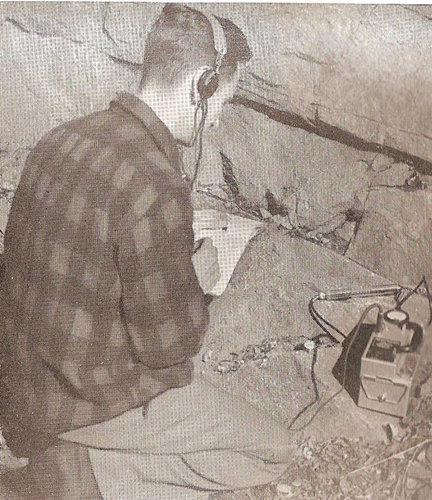
A prospector uses his Geiger counter to determine the radioactivity of a specific point in a a generally radioactive area. A background count was taken before this specific reading was made, from Prospecting for Uranium by AEC and USGS 1951. This picture also appeared in Grieger's Catalog 1950.
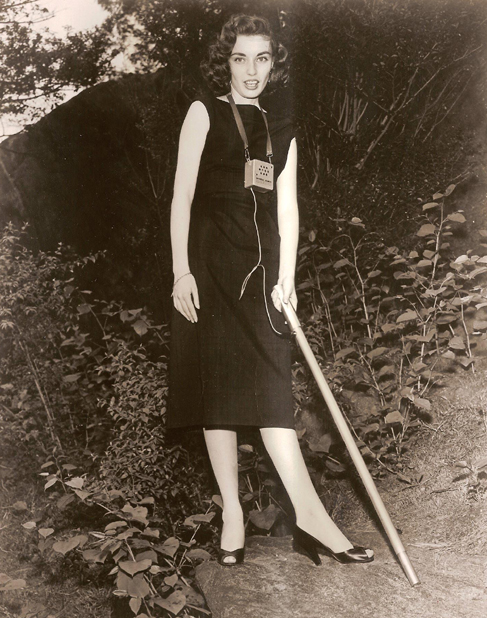
Walking Stick? No it's a new type of Geiger counter that Margie Pratt uses in a New York Park, Jun 1955.
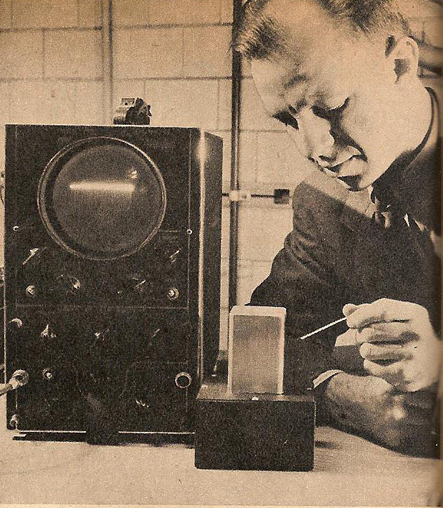
Dr. Marshall holds a radioactive wire near the new meter. It counts atomic explosions which appear as flashes on the oscilloscope from Radiation Meter Faster than Geiger Counter in Popular Science Oct 1947.


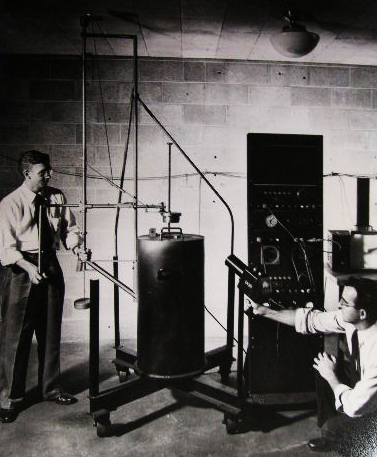
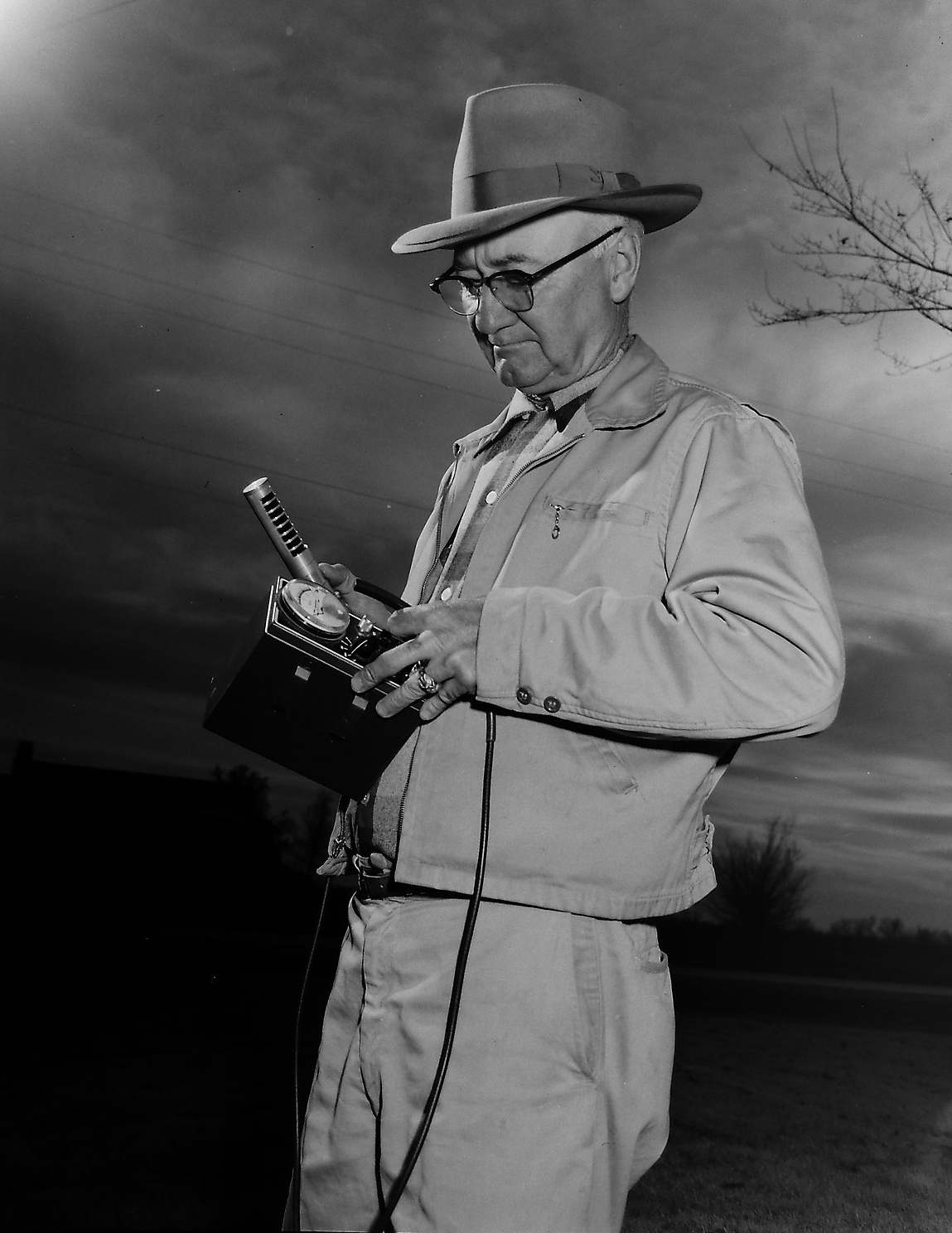
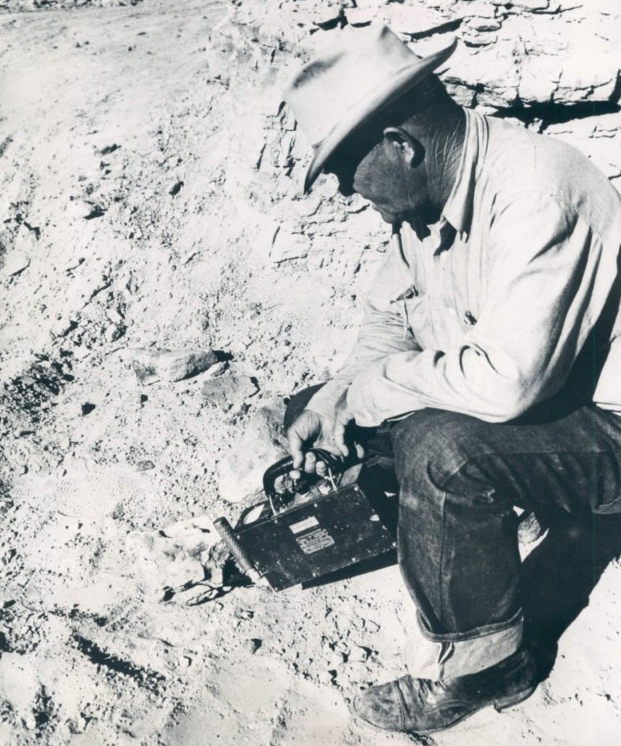
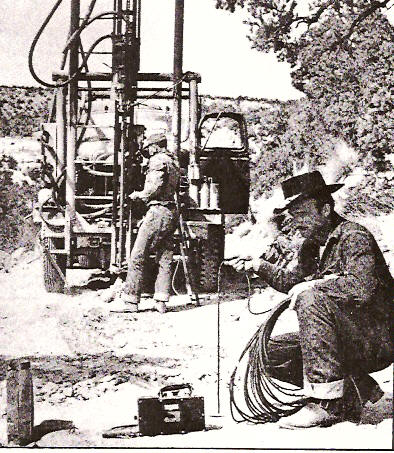
Drill hole operation using a Babbel Counter 1953

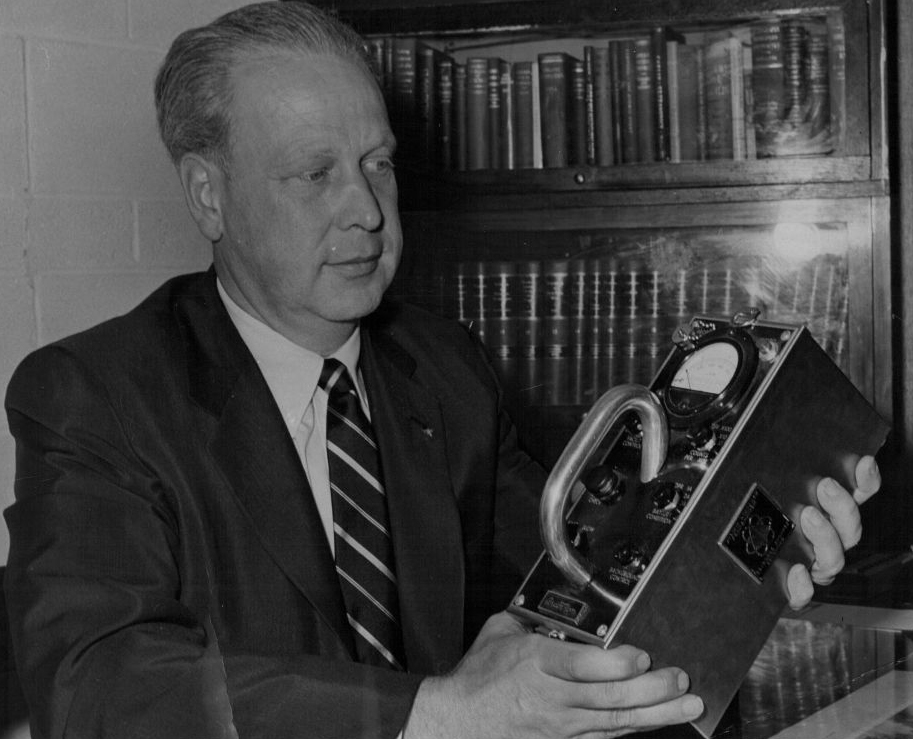
Henry C. Mulberger, president of Atomic Research Corporation, displays a Geiger counter made in his Colorado Springs plant, his products are also being shown in Europe, Jun 1955.
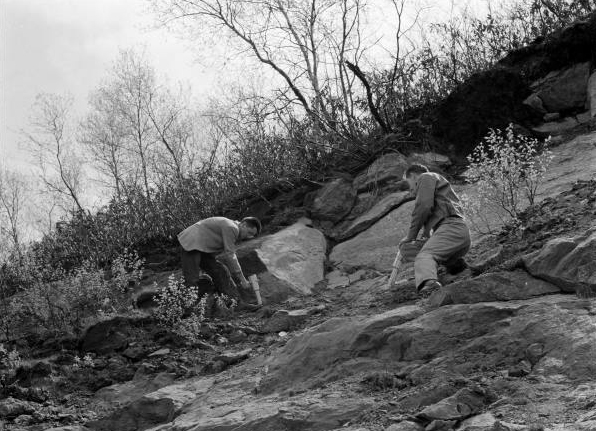
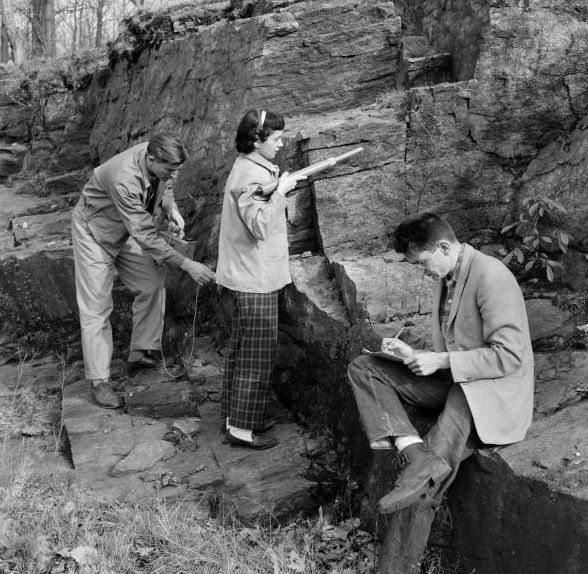
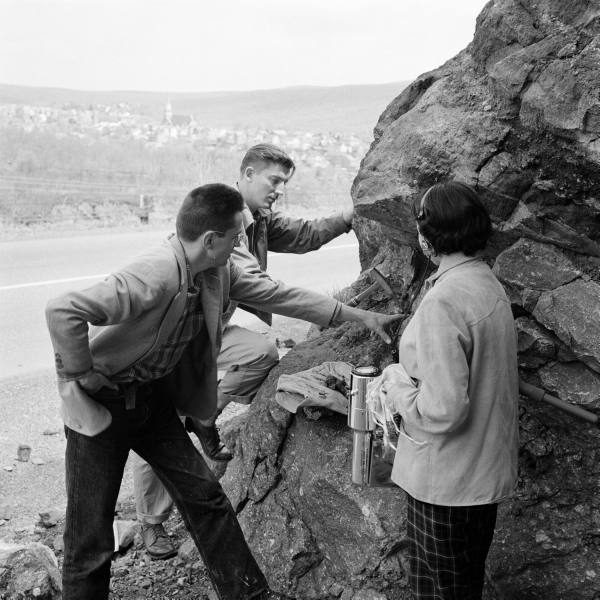

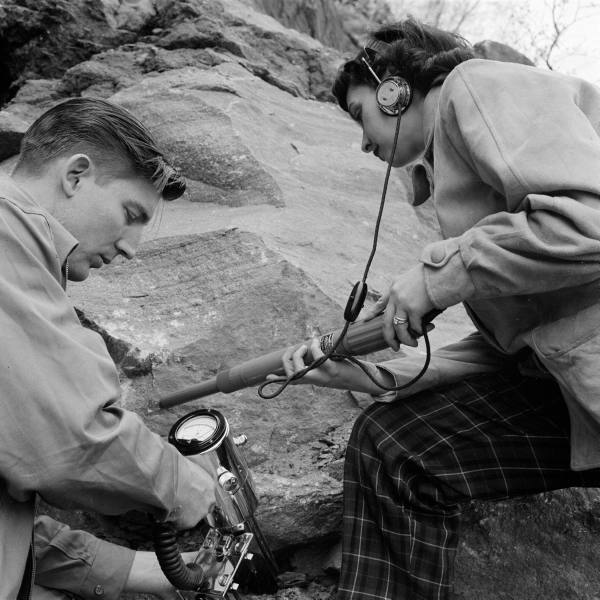
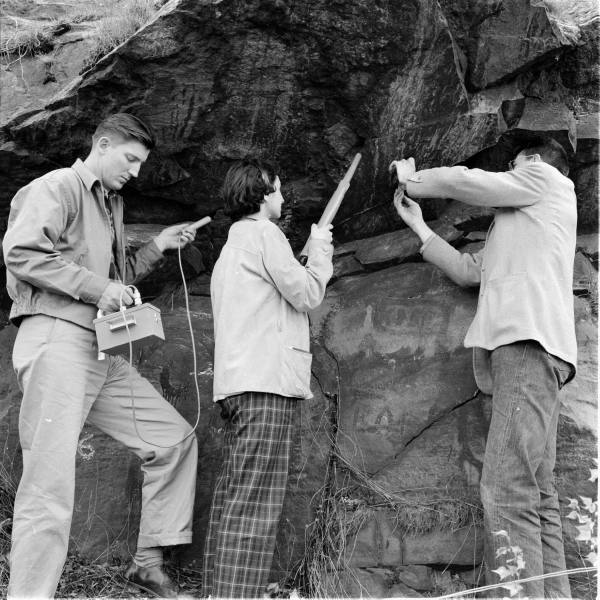
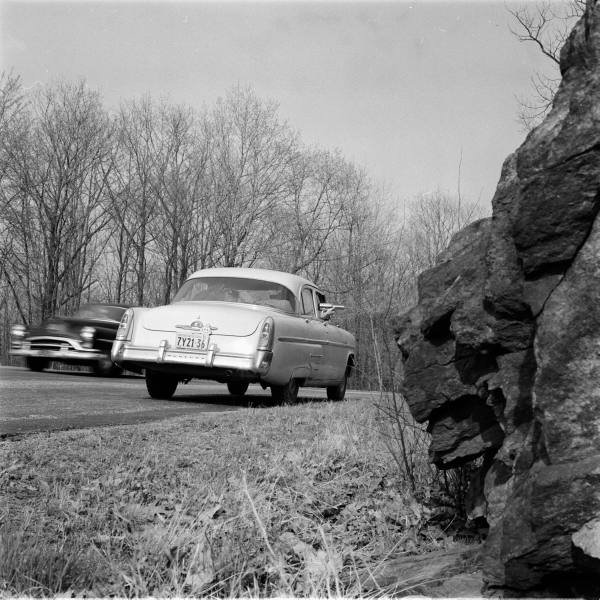
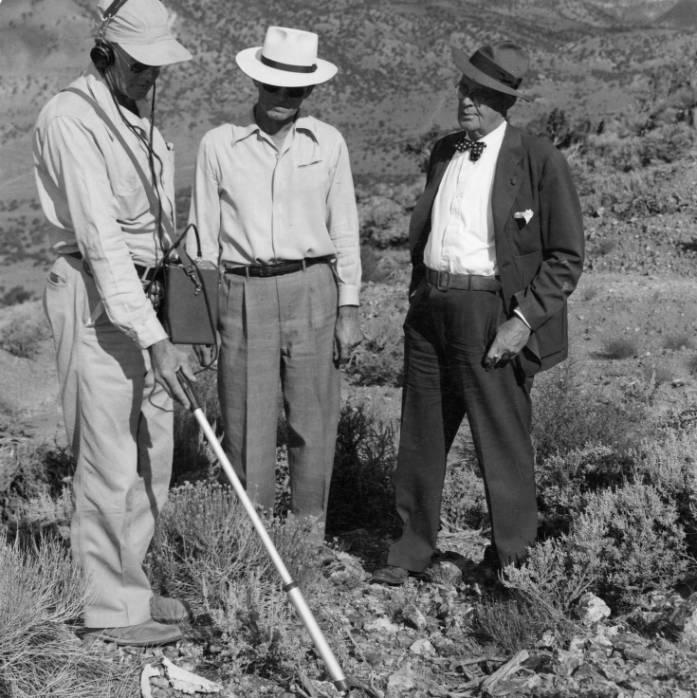
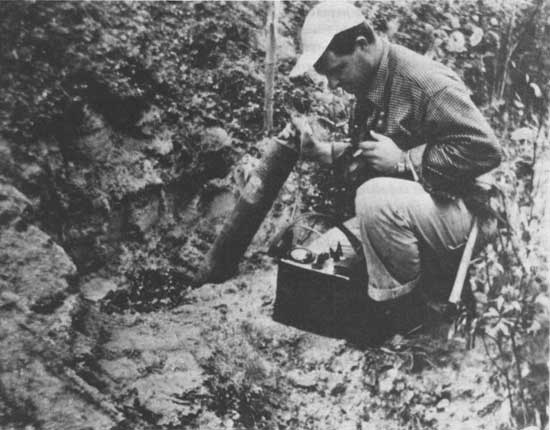
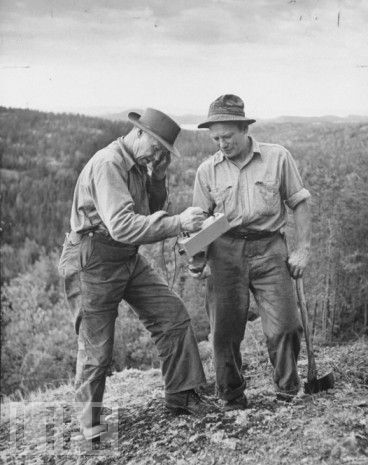
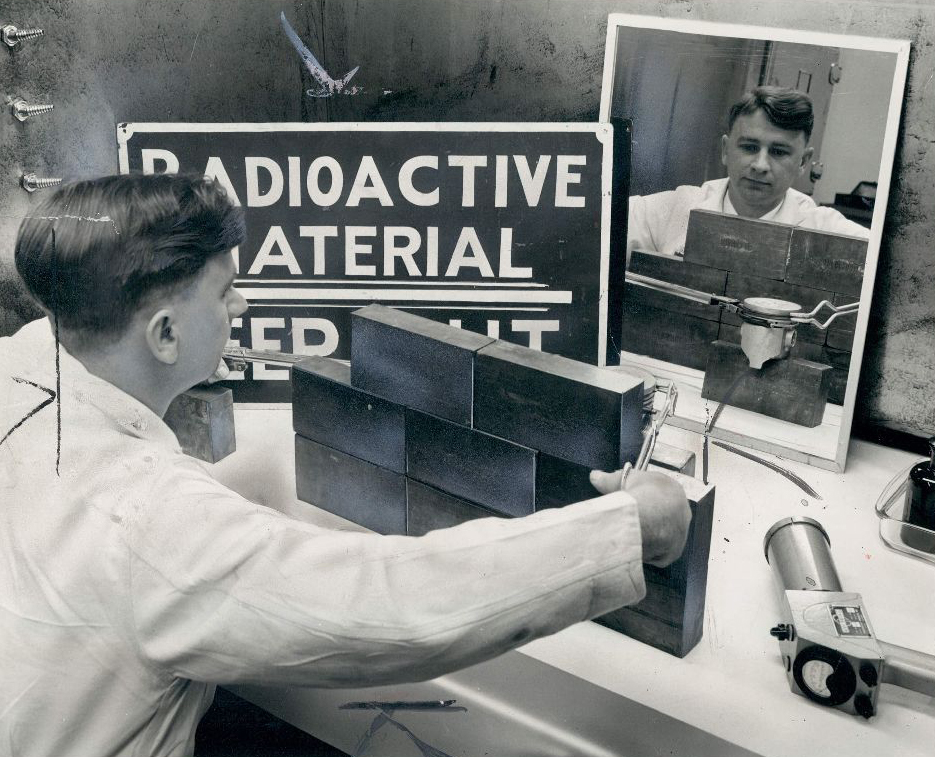
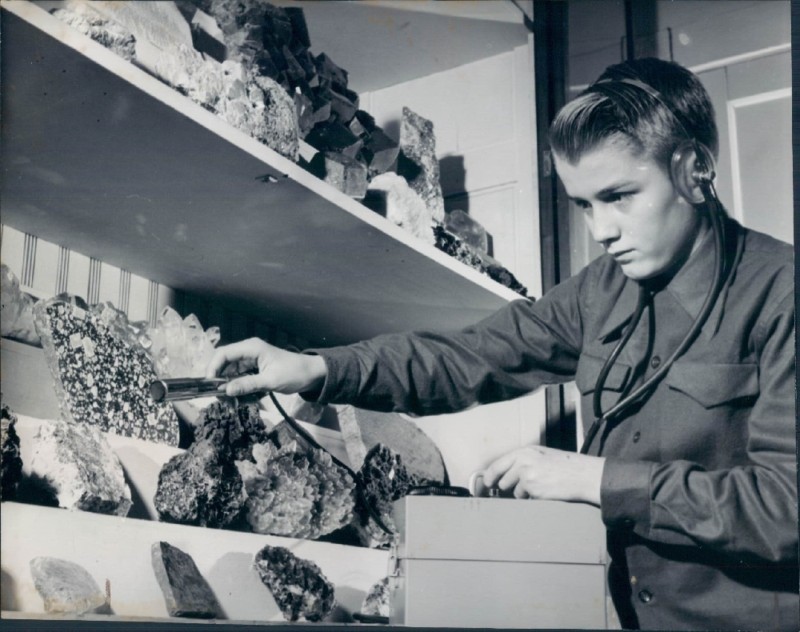
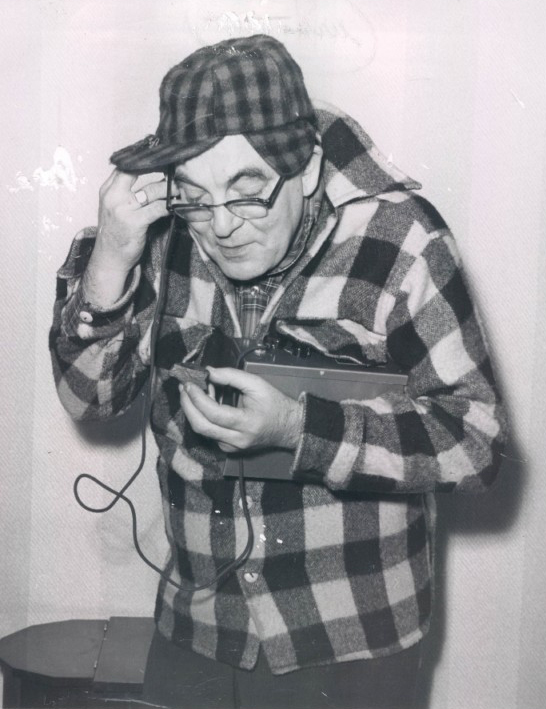
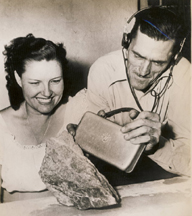
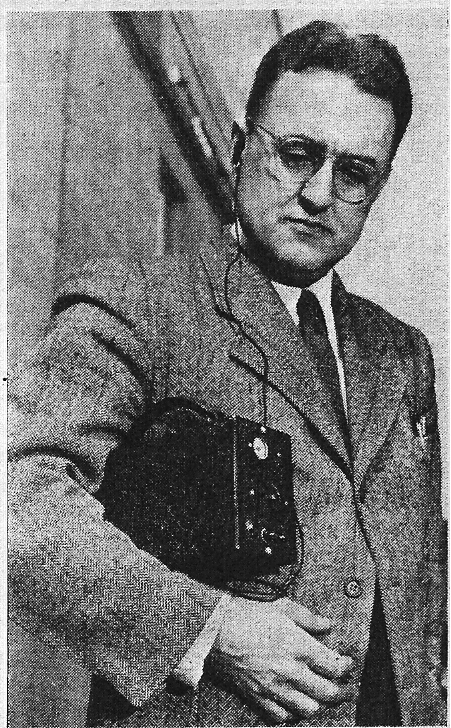
Miniature 9-1/2 ounce Geiger counter with earphone held by inventor R.G. Elson, physicist with Ontario Department of Health from X-ray and Radium Industries Geiger Counter 1946. Up until 1939, the Geiger counter was a heavy, unwieldy instrument limiting the uses to which it could be put and thus its worth. At the urging of Professor Edward Sampson, Dean of the School of Graduate Geology at Princeton University, a 40 lb. Geiger counter was constructed and tested. It was later reduced to 20 lbs. in 1943 and to 9-10 lbs. in 1944. The Elson model weighs just 4 lbs. 9.5 oz. The unit has a built-in seconds clock making one revolution each minute to time the clicks. It could find 10 mg radium needles at 20-30 feet. It has been used in hospitals to search for lost radium needles. Estimated cost is $150 in 1946 by the distributor X-ray and Radium Industries. It will have a loudspeaker, a neon light flash-type, and earphones. They note the unit could be used in a helicopter, referred to as a fan-like aircar, to drift lazily over the tree tops.
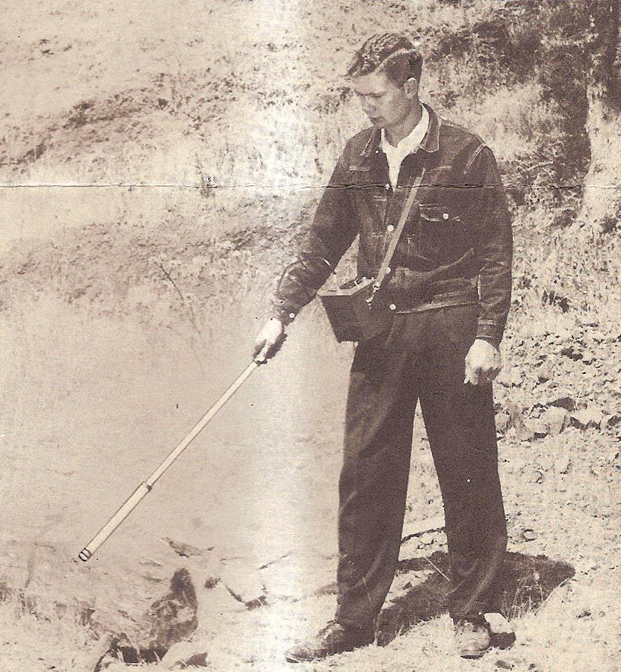
Fisher M-Scope Radiation Detector with Prospecting Stick - Type C-15 from The M-Scope flyer fro Fisher Research Laboratory 1950's
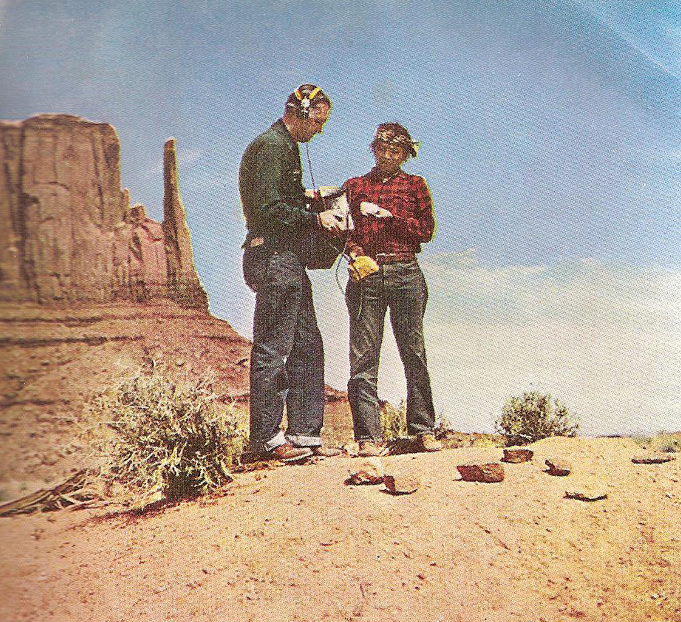
Trader Goulding shows Navajo prospector how a Geiger counter reveals radioactivity in piece of uranium ore from The Navajos Hunt Big Game by Harry Goulding in Popular Mechanics June 1950
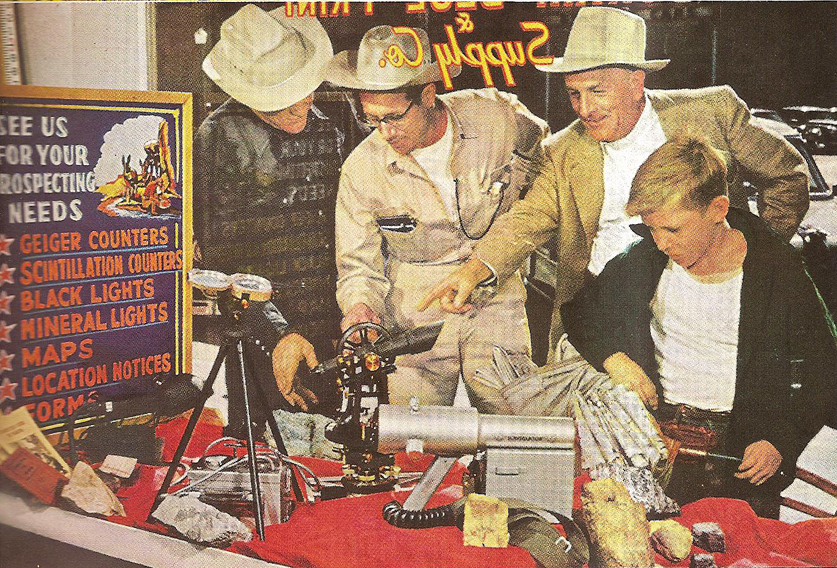
Prospect Fever Grips Old and Young Alike from Hunting Uranium Around the World by Robert Nininger and National Geographic Society 1953

When rock blooms yellow and Geiger counters rattle - uranium! by Robert Nininger and National Geographic Society 1953
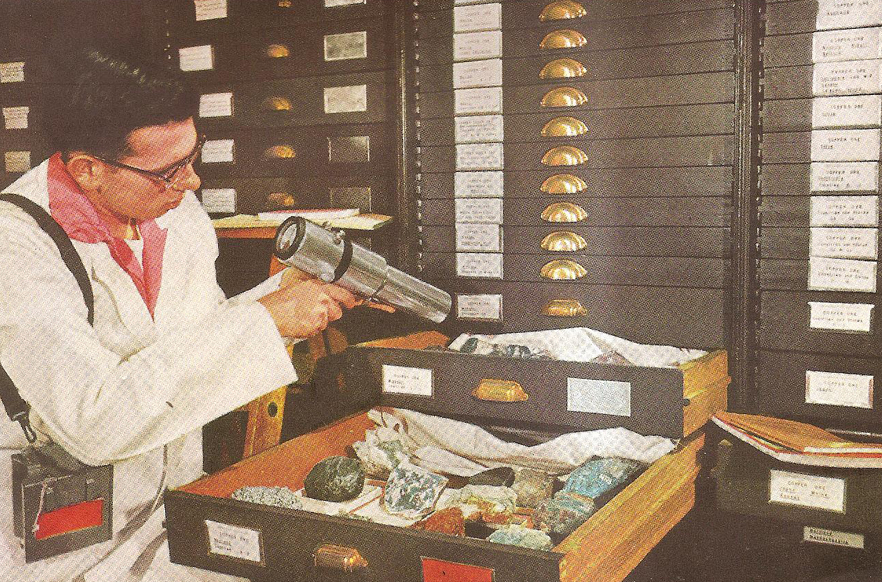
Not even museum rocks escape ray tests by Robert Nininger and National Geographic Society 1953
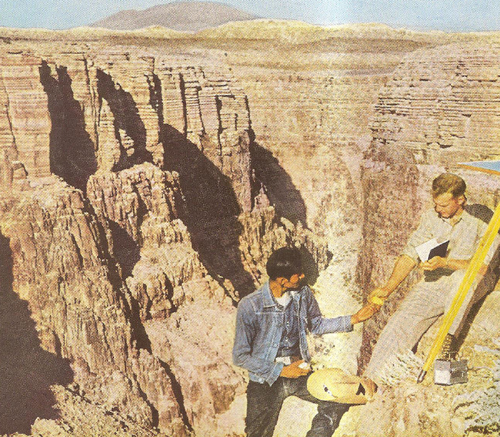
Measurements on a canyon wall by Robert Nininger and National Geographic Society 1953
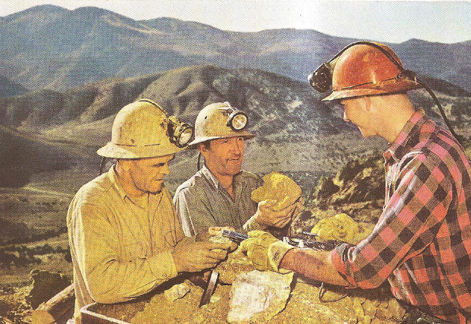
It looks good! Utah miners exclaim by Robert Nininger and National Geographic Society 1953
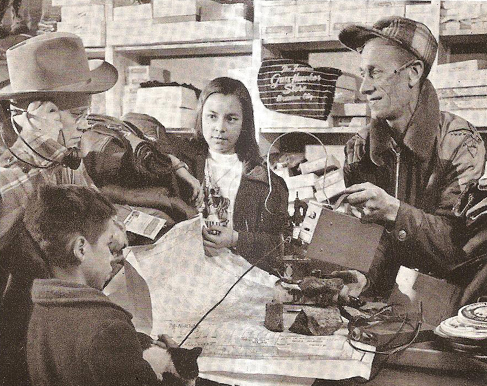
Guss Hawker sells everything from cosmetics to claims by Robert Nininger and National Geographic Society 1953
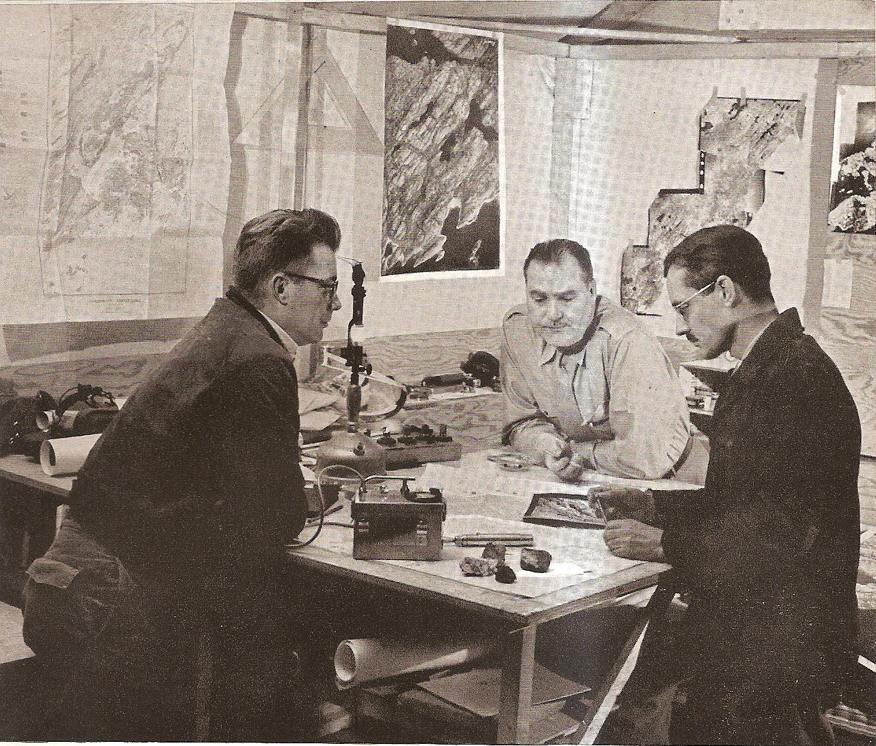
Aerial photographs help modern prospectors in their search for hidden riches by Robert Nininger and National Geographic Society 1953
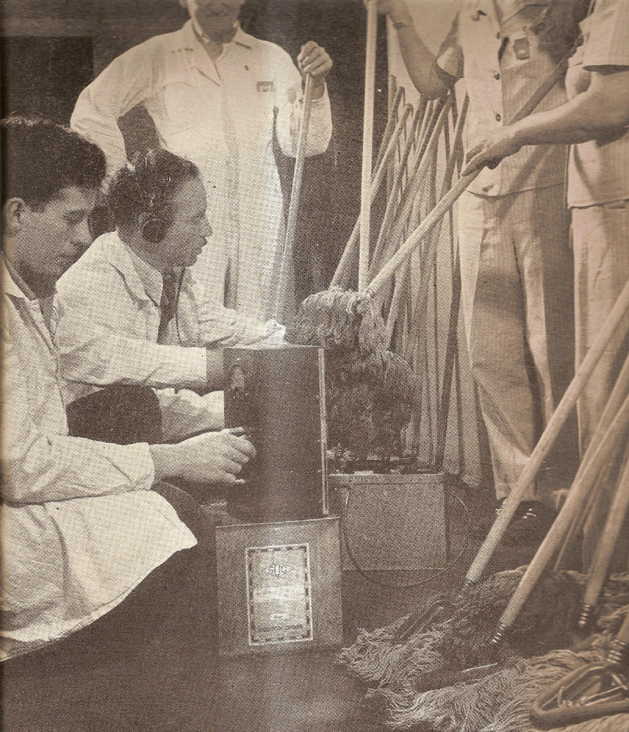
Even the mops need to be checked for radioactivity when processing plutonium from Life Magazine 1946

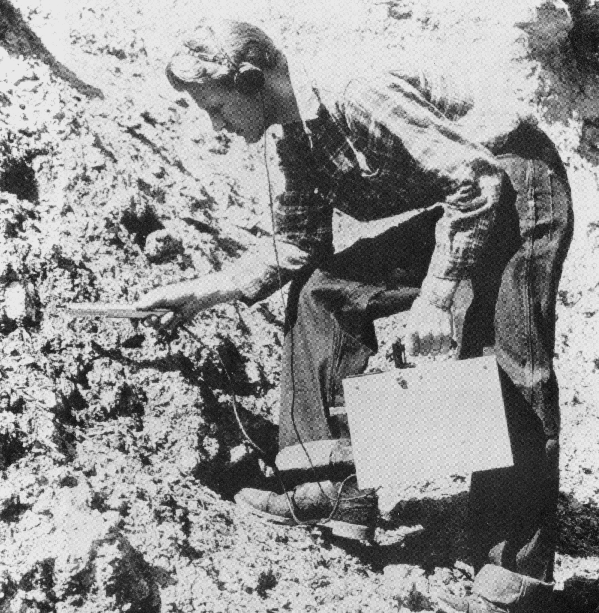
W.R. Hanson of Victoreen Instrument Co. checking portable survey meter, from Health Physics: A Backward Glance by R. Kathren and P. Ziemer, 1945.
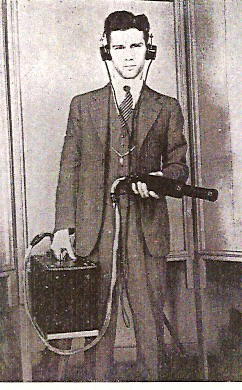
Locher demonstrates the Herbach and Rademan Instrument 1936
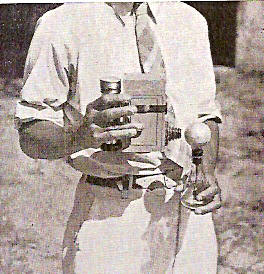
Dr. Taft demonstrating the electroscopy 1926
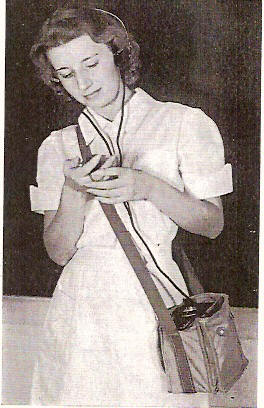
Taft Portable Geiger Muller Counter with Operator 1942
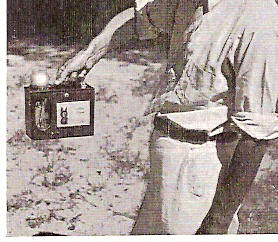
Dr. Taft with Radium Detector 1937
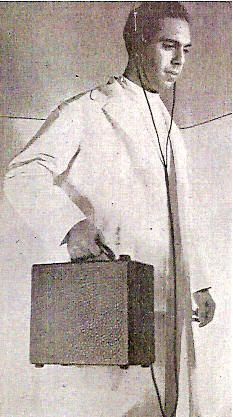
Dr. Weinstein with Geiger Muller Battery Powered Counter 1938
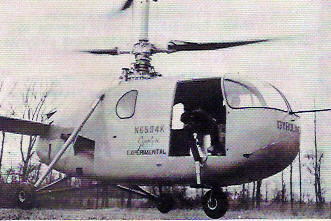
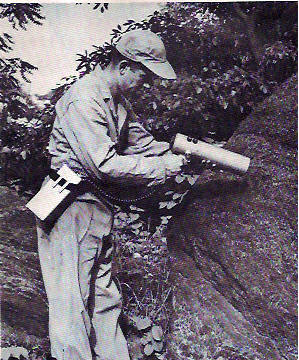
Radiac Company Scintillometer in Aircraft or on Foot 1950
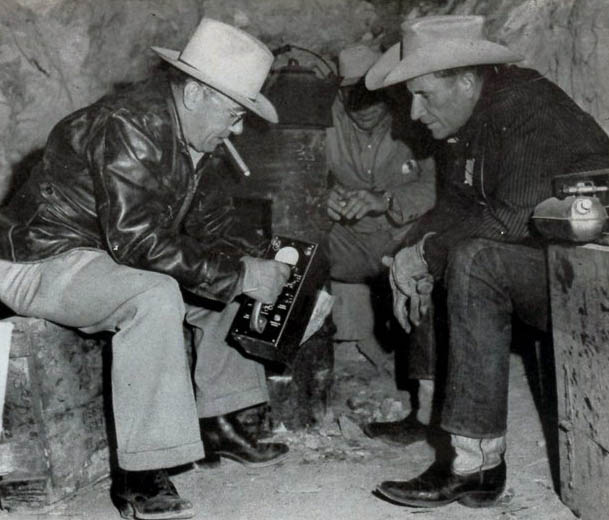
Uranium hunters test a sample of ore with a multi-tube instrument. Rugged and sensitive, this is the newest of the four major types of counters, from How to Choose a Geiger Counter by G. Borgeson and F. Baker, 1956.
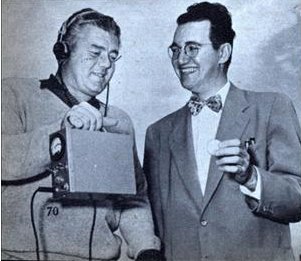
Atomic Golf Ball 1950's
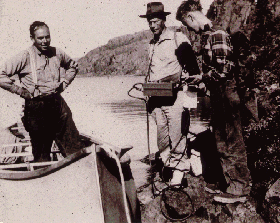
Canada Survey Group 1944
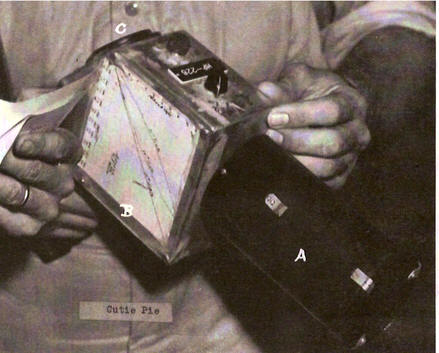
Stafford Warren Collection Cutie Pie 1950's
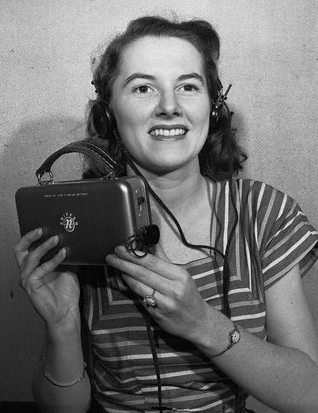
Nuclear Instruments Sniffer 1950's
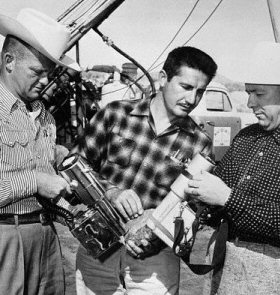
Scintillaors being tested prior to use 1950's
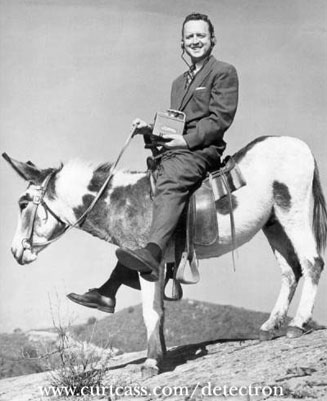
Detectron (used with permission) 1950's
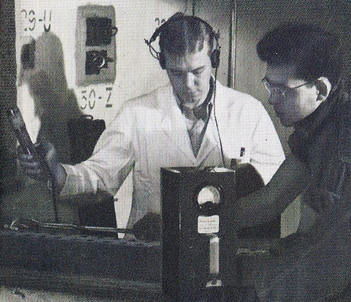
University of Chicago MET Lab using Zeus Detector 1947
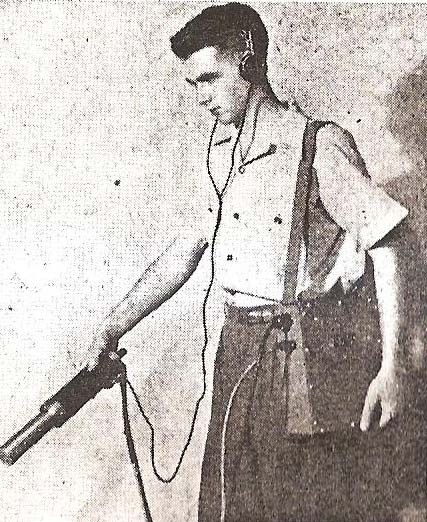
A representative Geiger Counter field unit operated by a dry battery is easily and conveniently carried over the shoulder. Manufactured by Herbach and Rademan of Philadelphia, PA 1947.
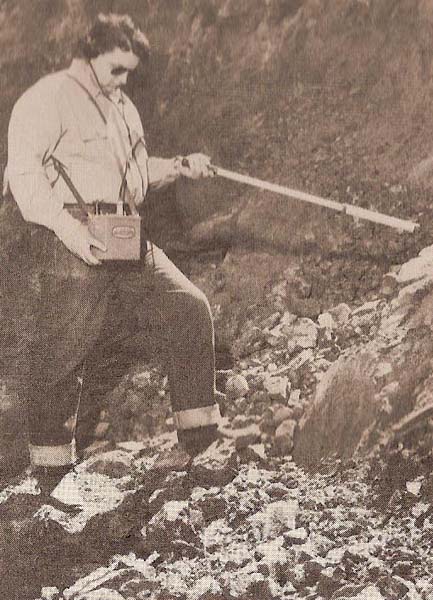
A counter sealed in the end of a tube enables the prospector to check difficult places, from Trailing the Wild Atom by J. Laudermilk and Fisher Research Laboratory, 1950s.
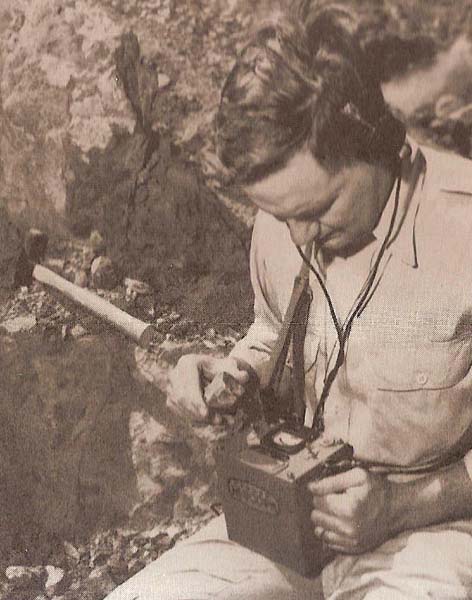
A rich piece of canonite this close to the window can make a Geiger counter - and a lucky prospector - go wild, from Trailing the Wild Atom by J. Laudermilk and Fisher Research Laboratory, 1950s.
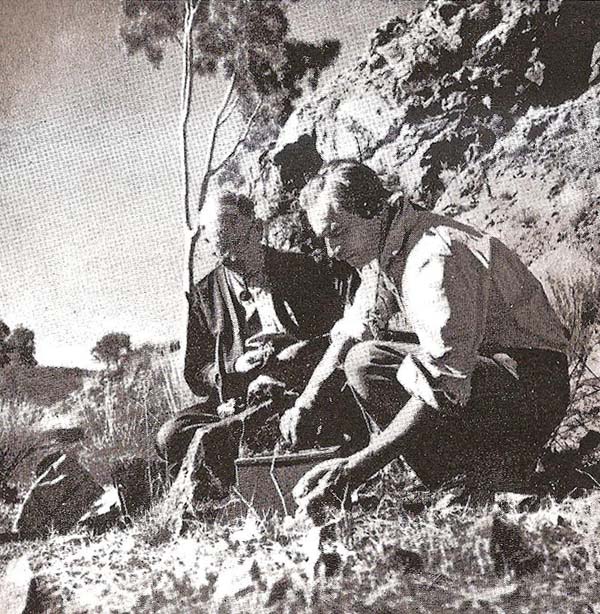
Searching for uranium ore with the Rate-meter, Hartz Range, Central Australia, from Fortunes in Minerals including Uranium by I. Idriess, 1950s.
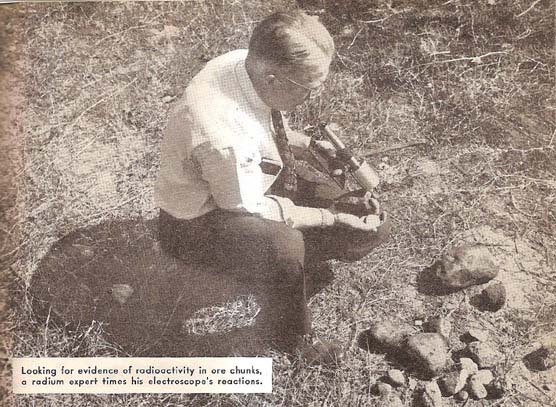
Looking for evidence of radioactivity in ore chunks, a radium expert times his electroscopes reactions, from How to Hunt for Uranium in Popular Science, 1946.
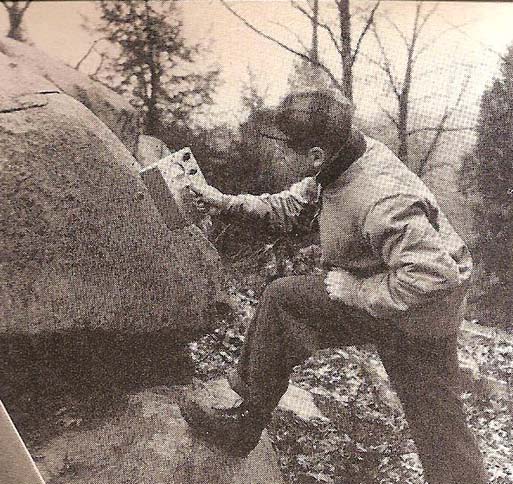
Uranium fever is in the air. Your favorite camp spot, fishing grounds or summer homesite could be a modern El Dorado. This six tube instrument not only spots radioactivity, but measures it, from Super Geiger Counter you can Build by H. McEntee in Popular Science, 1955.
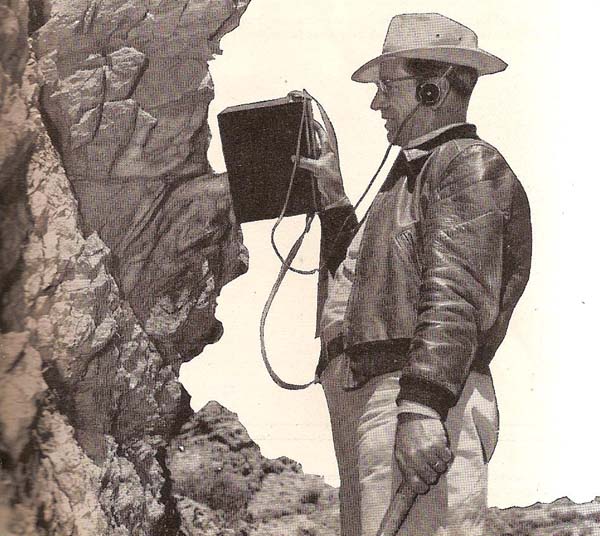
Fireman strikes uranium with a Popular Mechanics Geiger Counter, by G. Borgeson in Popular Mechanics 1955.

Ashby determine value of ore sample by holding it against tube of his assay counter, watching needle, by G. Borgeson in Popular Mechanics 1955.
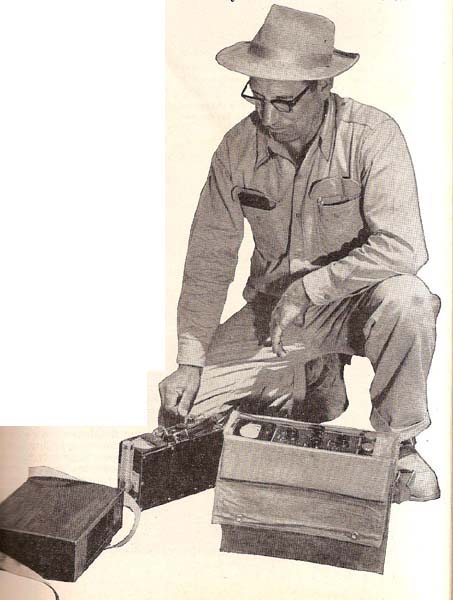
Today Ashby's instrument, in addition to old Popular Mechanics counter, left, include assay counter, center, that tells percentage of valuable ore in sample and scintillometer with long-range sensitivity, by G. Borgeson in Popular Mechanics 1955.
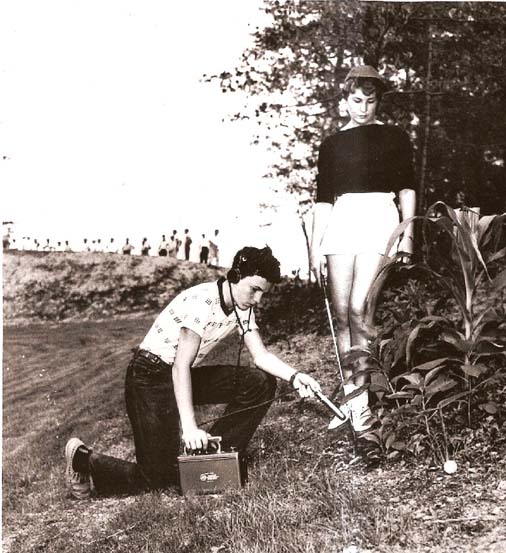
Caddy John Gullickson finds a lost golf ball (radioactive) with a Geiger Counter as a new golf course opened here today in the Great Smoky Mountains. The player is Miss Trula McMahan, "Miss Gatlinburg" who was on hand to play the course on opening day, United Press Photo, 1955.
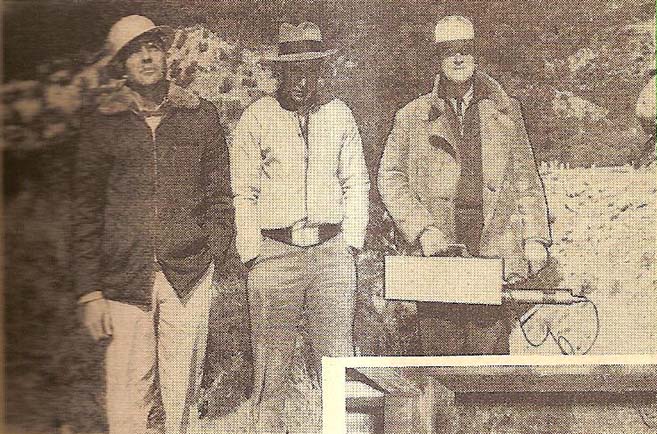
Brooks Mann and Chris Musick, tow of the discoverers of the Micracle Mine and Stewart Patterson, min manager, from The Bakersfield Uranium Rush by L. Sands in Popular Electronics 1955.
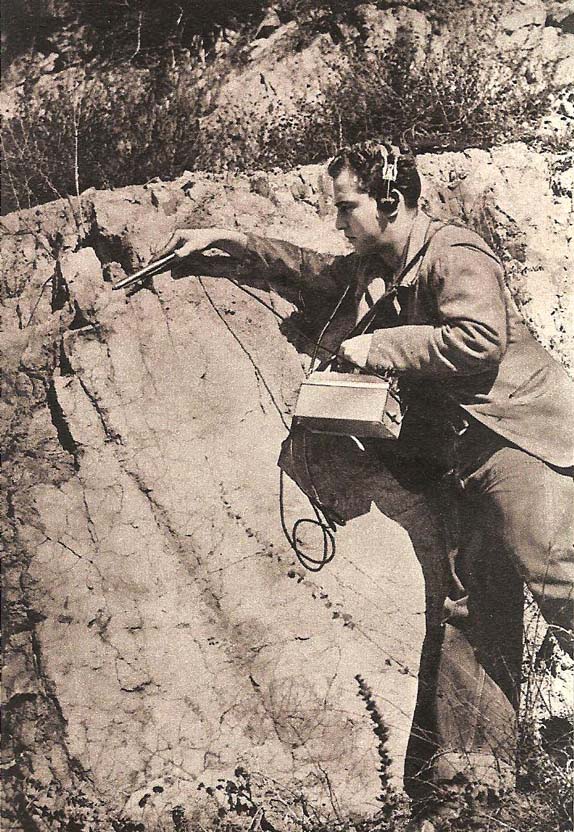
This 20th-century '49er is looking for uranium - not gold. He carries a radiation counter which reveals radioactivity in rock. Here he has lifted the counter tube from the unit to test ledge, from '49 Uranium Rush in Popular Mechanics, Feb 1949.
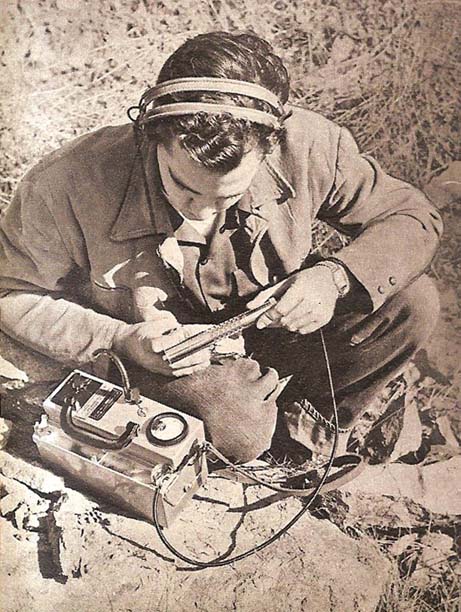
In the field - prospector holds "probe" containing counter tube to rock sample, from '49 Uranium Rush in Popular Mechanics, Feb 1949.
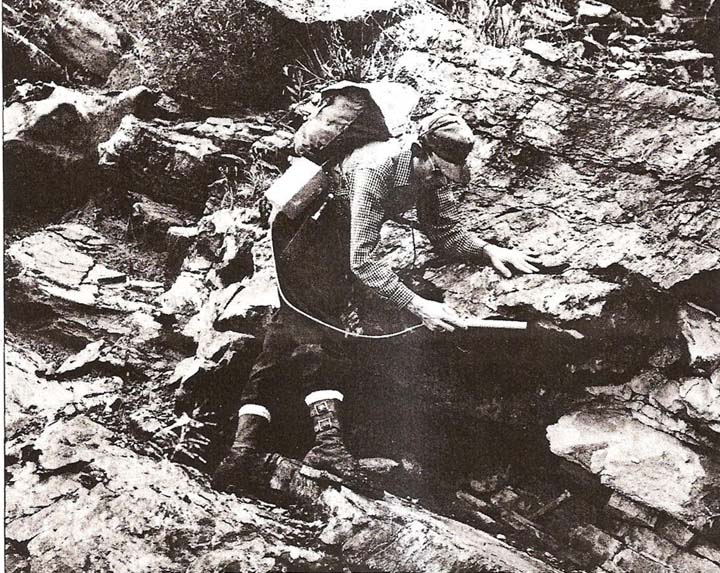
A prospector equipped with a detection instrument and earphones searches for traces of uranium ore, in Uranium and Other Miracle Metals by Reinfeld 1955
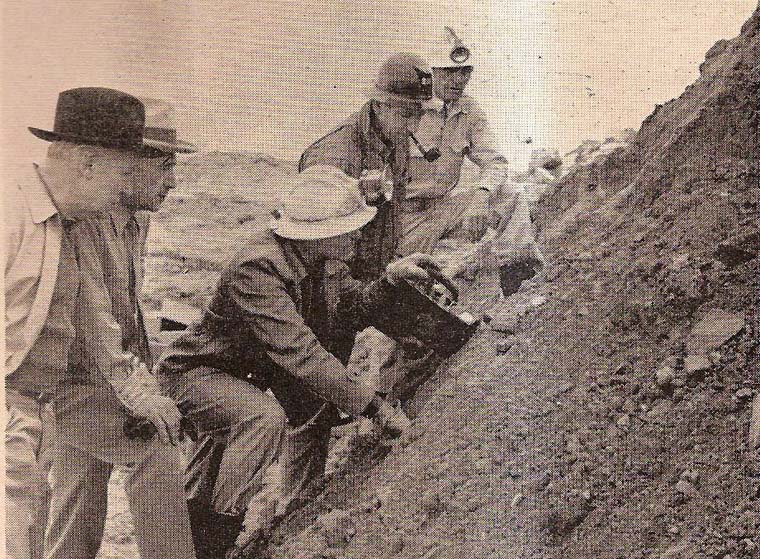
Officials of the Four Corners Uranium Corporation inspect an ore stockpile at the Green River property now in production. Holding a wilding clicking Geiger counter to the stockpile is W. R. Bronson while looking on from left is E.H. Sanders, president of the corporation, 1955
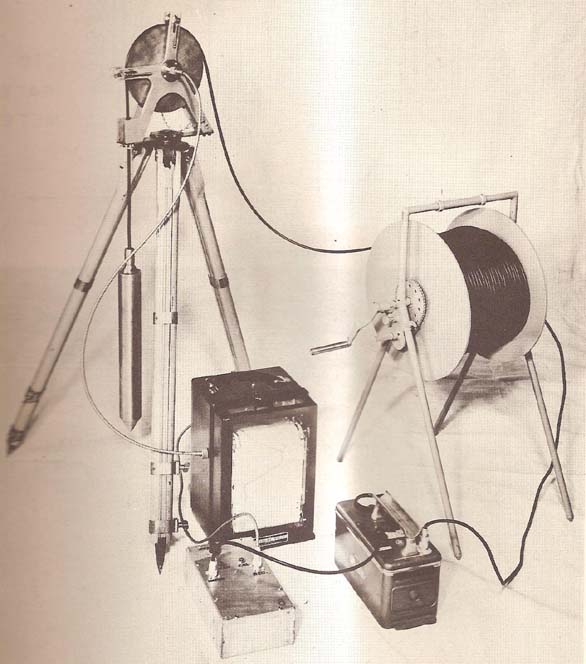
Well logging system for uranium prospecting 1952
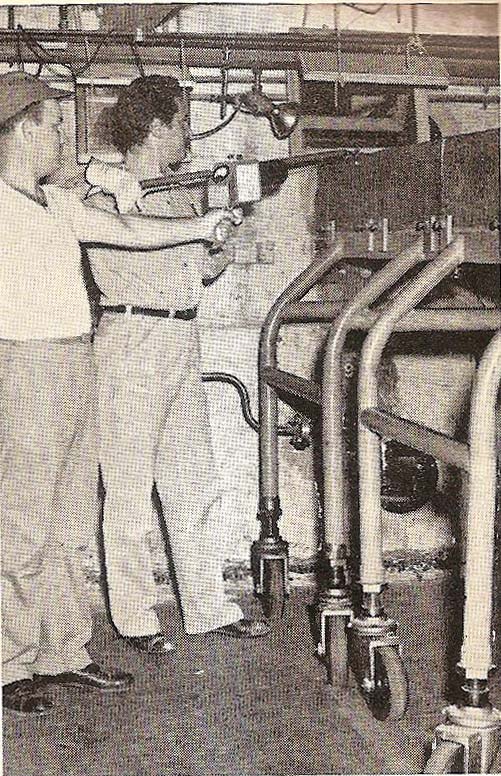
Radioactive material taken from the pile is now dangerously radioactive. Worker at left hold radiation meter for safety check. The material - gold - will be put in heavy lead shields to the right, Oak Ridge Laboratory 1947.
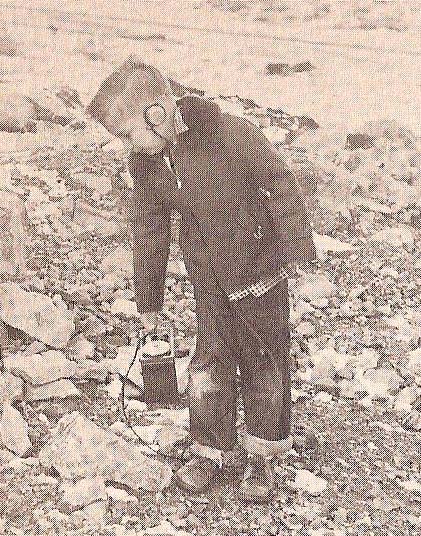
Children make devoted prospectors. Given a fairly simple counter, they can spot high readings and cover lots of ground, Uranium Official Yearbook 1955.
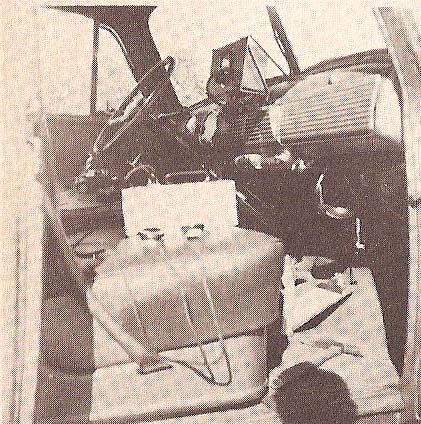
Cab of exploration specialist's pickup contains permanently mounted remote meter plus extensive equipment for shoe leather prospecting, Uranium Official Yearbook 1955
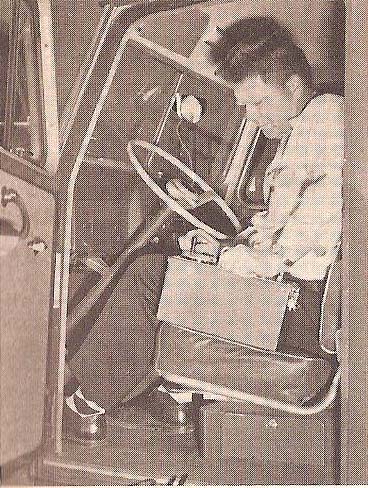
Jeep station wagon is weather tight, carries big payload, goes anywhere, Uranium Official Yearbook 1955
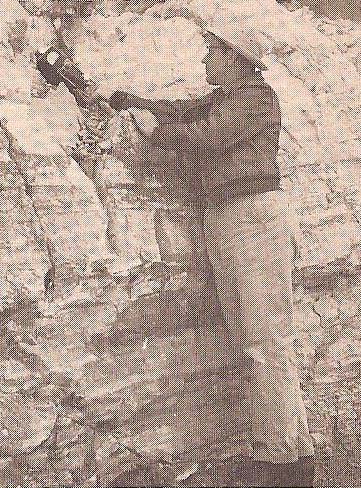
From coast to coast, amateur prospectors are taking counts of nearby rock outcrops, Uranium Official Yearbook 1955
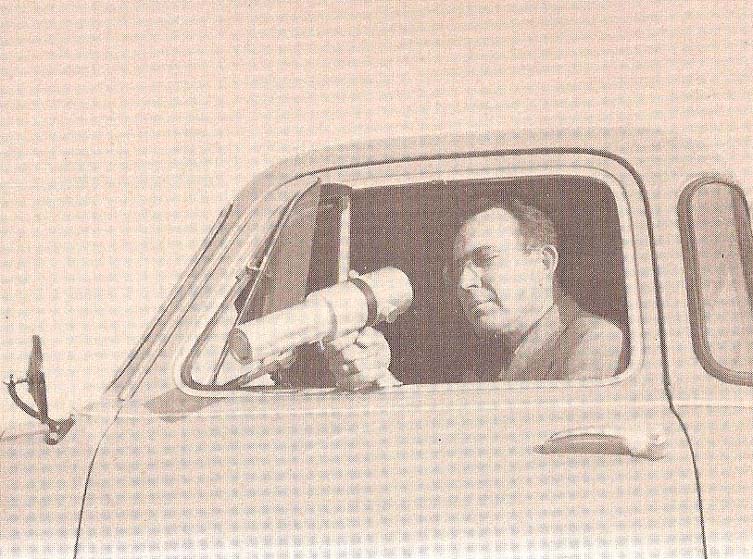
Henry Brooks Mann does his prospecting with a Scintillometer and a pick-up, Uranium Official Yearbook 1955
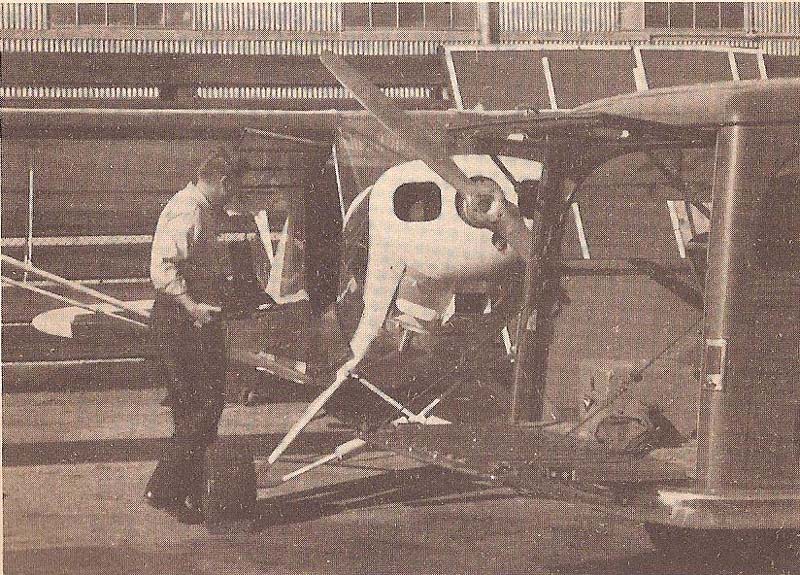
Piper Super Cub is "jeep in the air" and the two vehicles form a well-matched team, Uranium Official Yearbook 1955
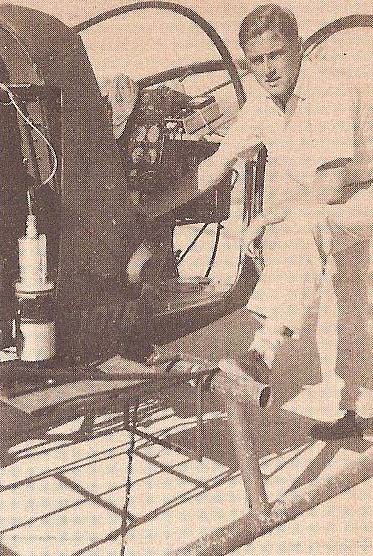
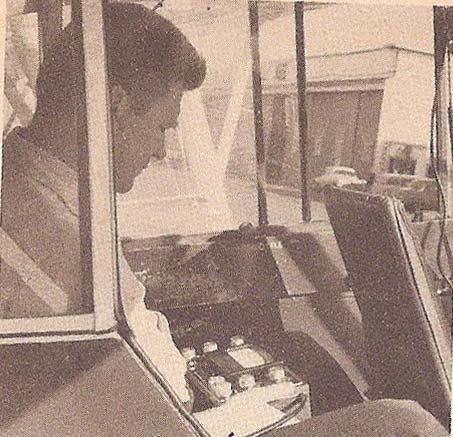
Helicopter equipped with scintillation counter. These craft can sit down anywhere, permit taking samples in the field during air reconnaissance. Two men should be used for airborne prospecting. Flying the uranium country is enough work for one man; helper handles counter, Uranium Official Yearbook 1955
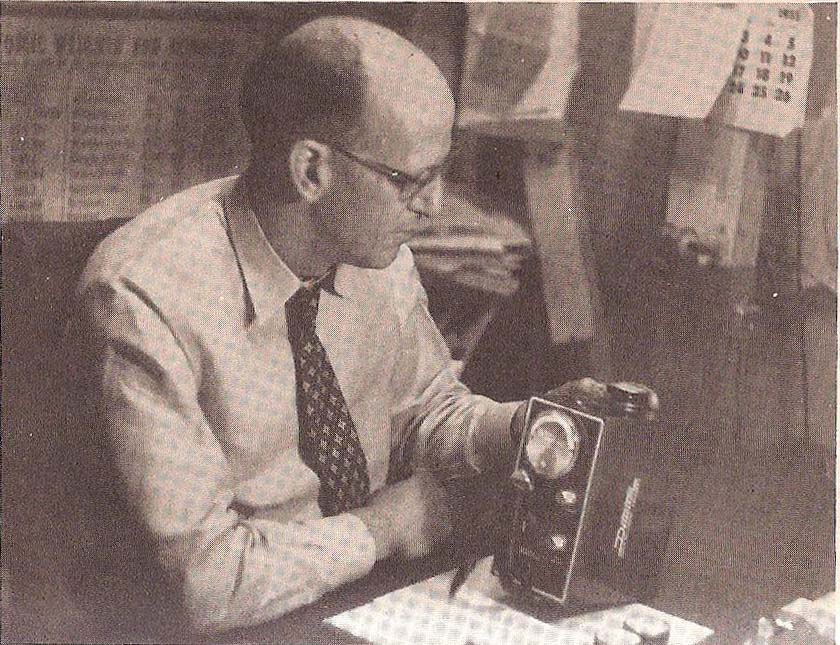
Dr. Gordon Locher demonstrates taking counter reading with a standard sample, Uranium Official Yearbook 1955
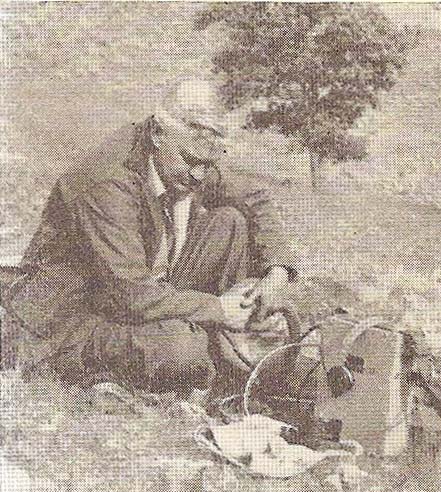
Taking a reading of radioactivity in the field with portable Geiger counter, Handbook of Uranium Minerals 1948
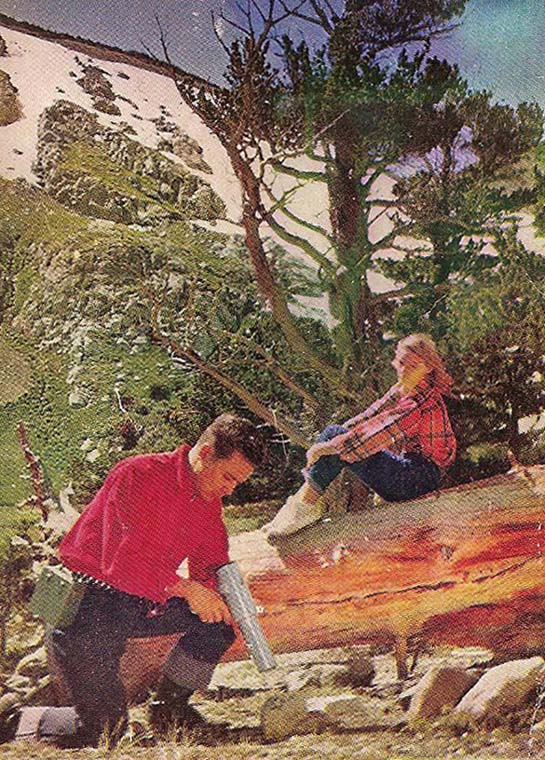
Uranium Prospector's Handbook 1954
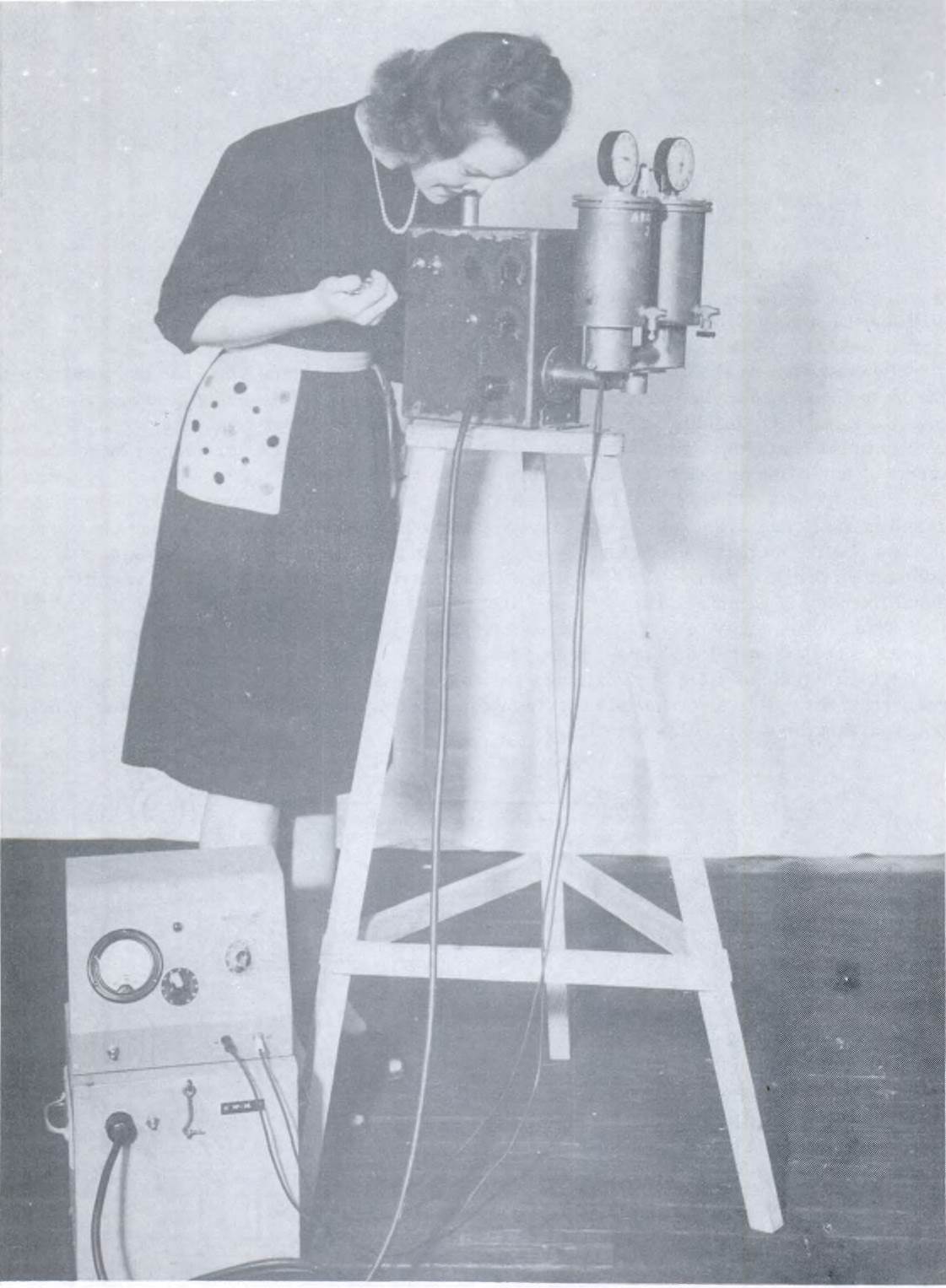
Cambridge Instrument Company Chang and Eng 1944
